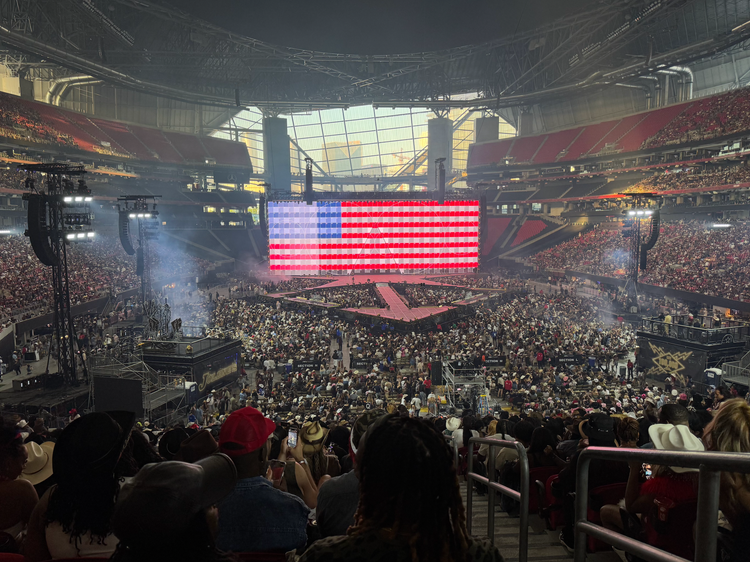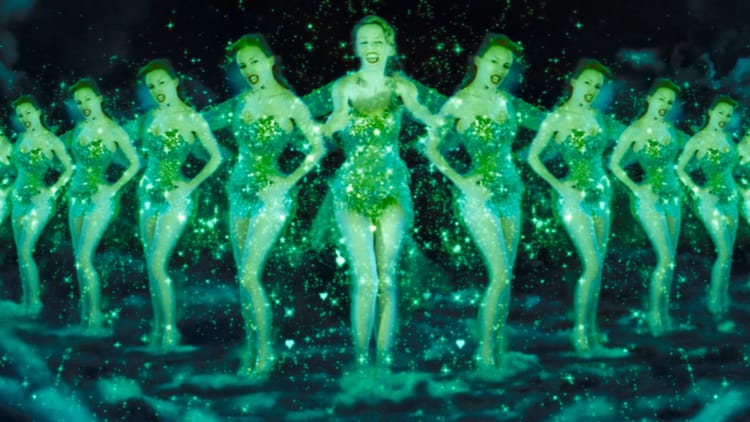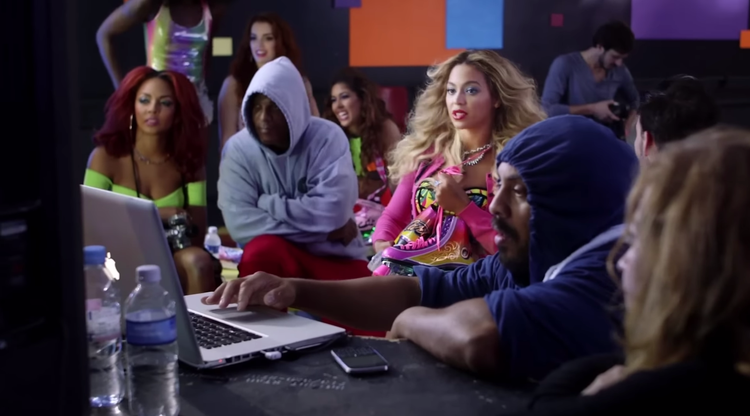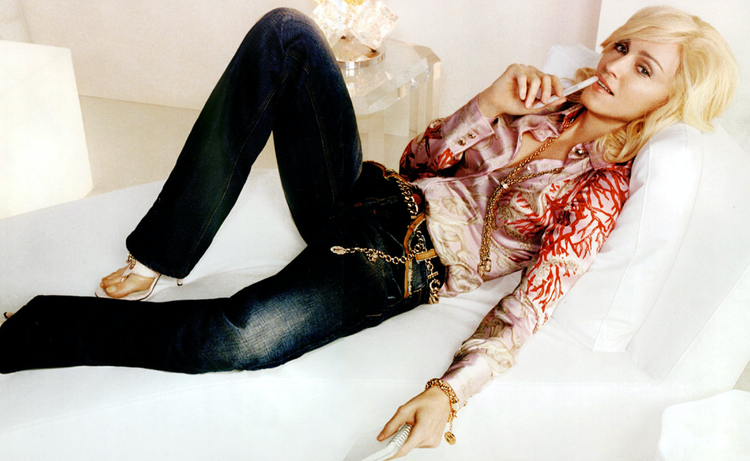A Moving-Image History of Parkwood Entertainment, Vol. I

This is the first of a four-chapter series on Beyoncé’s Parkwood Entertainment and its extensive film output.
In this chapter, I cover everything that happened before the company was founded in 2008, from the star’s birth through B’Day and Dreamgirls. It’s most geared towards someone who’s read my introduction, where I explain how this series came to be and what some of my goals are for it.
This project is being published for free, but please subscribe if you’d like to know about new chapters as soon as they drop. You can read more about this newsletter here.
Beyoncé Giselle Knowles was born on September 4, 1981 in Houston, Texas—five weeks after the launch of MTV. She’s never existed in a world where popular musicians haven’t lived or died, professionally speaking, on their visual output. But she happened to grow up idolizing a handful who treated that idea as a floor rather than a ceiling. Here are some of their names and exploits; we’ll get into lots more later.
When Beyoncé was two, superstar Michael Jackson released a 14-minute video/’50s B-movie spoof called “Thriller” (1983), which the Knowleses would watch as a family around their television set. The bar for music videos—and for pop superstardom in general—had forever been raised, with the artist himself preferring to call his own “short films” for the rest of his life, a habit his fanbase would adopt.
When Beyoncé was four, newly-minted movie star Prince chose to self-direct his next film, Under the Cherry Moon (1986), a stylish romantic dramedy that—as had been the case with Purple Rain (1984)—was soundtracked by his album from that year, Parade. Despite Cherry Moon’s critical failure, Prince would direct three more movies starring himself over the course of Beyoncé’s childhood, all tied to various albums.
When Beyoncé was seven, Jackson starred in an experimental film called Moonwalker (1988), a feature-length collection of videos from Bad (1987) broken up by live performances and scripted scenes. Though it wasn’t released theatrically in the United States—there, it was a best-selling home video—it marked Jackson’s first silver-screen appearance since Sidney Lumet’s The Wiz (1978), a childhood-defining film for both Beyoncé and little sister Solange, born in 1986.
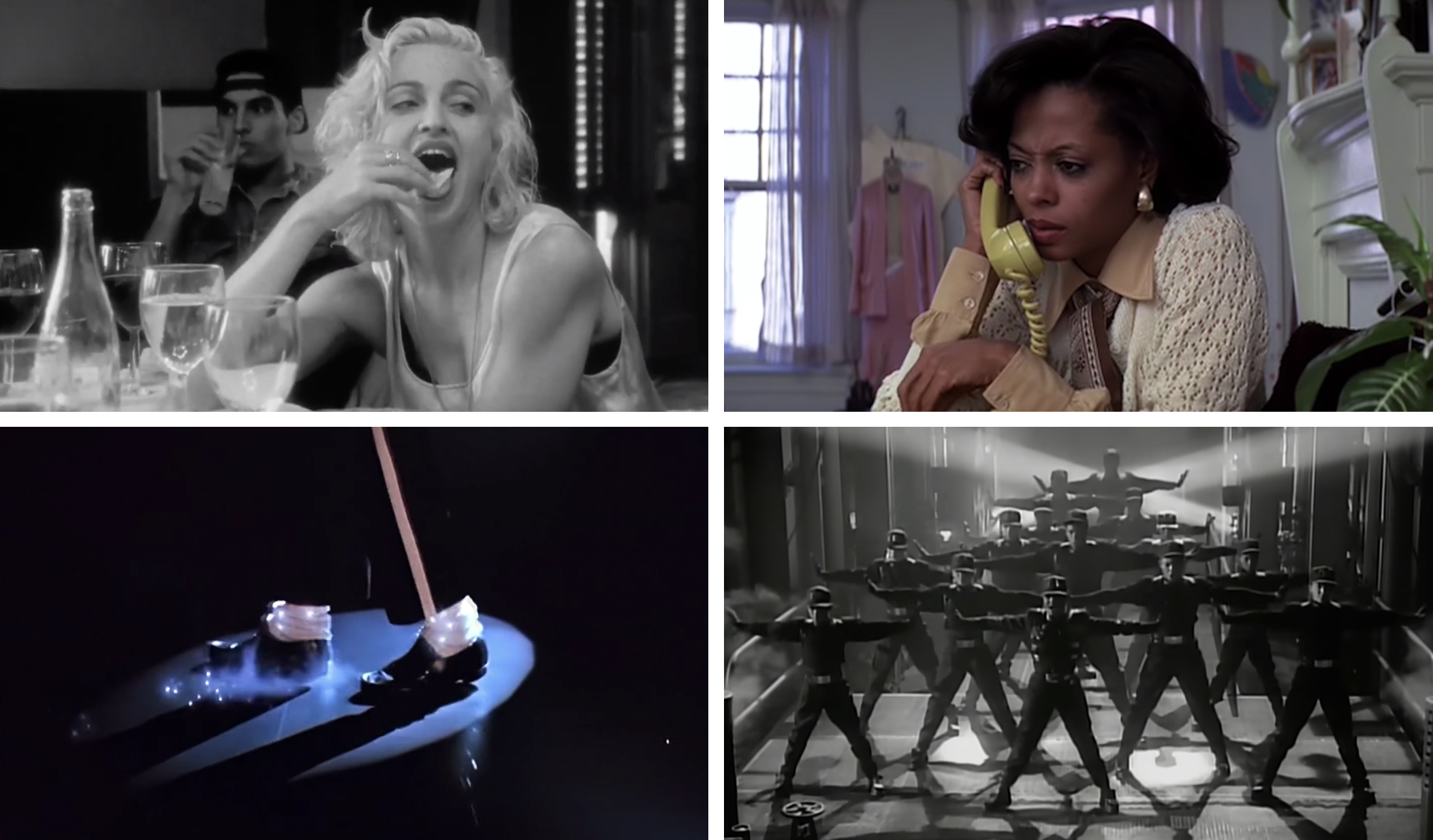
The Wiz is one of multiple ’70s films that Beyoncé would later cite somehow; she’s been a vocal devotee of that other infamous Diana Ross vehicle, Berry Gordy’s Mahogany (1975), and has pointed to the comedy Cooley High (1975) and musical Sparkle (1976) as other favourites. It’s worth spelling out that the common denominator in these titles is Ross, who graces each with her singing voice or life story if not her physical self.
Days after Beyoncé turned eight, Michael’s sister Janet put out her own ambitious longform project, Rhythm Nation 1814 (1989), which strung together multiple videos from her album of the same name. The two Jacksons’ films would ultimately compete against each other at the Grammys for Best Long Form Music Video—the category now called Best Music Film—with Janet taking home the award. Though the younger Jackson had been on TV practically since birth, Rhythm Nation 1814 was technically her first film, and she’d remain in the space consistently for the next two decades.
When Beyoncé was ten, Madonna—a hit-and-miss actress who’d eventually pivot to directing—co-founded a company called Maverick. Beginning with the release of the album Erotica and the coffee-table book Sex in 1992—natural next steps after the purposeful provocation of “Justify My Love” (1990) and the groundbreaking documentary Truth or Dare (1991)—it served as the superstar’s headquarters for the next decade or so. During that time, the company’s various arms would sign artists like Alanis Morissette and Michelle Branch ahead of their breakthroughs, release the soundtracks for The Matrix (1999) and two out of three Austin Powers movies, and produce both Agent Cody Banks (2003) and its sequel.
When Beyoncé was 11, Whitney Houston made her film debut in romantic thriller The Bodyguard (1992), playing fictional pop diva Rachel Marron. That it was a critical disaster has largely been eclipsed by Houston’s choice to executive produce its soundtrack, the Album of the Year winner that remains the best-selling soundtrack ever and the best-selling album by a woman. Houston would appear in a handful of other movies (including the 2012 Sparkle remake), but her most interesting cinematic legacy is arguably as the producer of numerous titles beloved by young girls; there’s of course Cinderella (1997), in which she starred alongside Brandy, but she also helped bring you the Princess Diaries and Cheetah Girls franchises.
When Beyoncé was 15, Michael Jackson made another film called Ghosts (1996), for which three songs from his ninth album and follow-up remix project were turned into an Edward Scissorhands (1990)-like story riffing on his complicated public image. (With the help of makeup and prosthetics, he plays five different characters.) If “Thriller” had been markedly cinematic in its B-movie references and hiring of director John Landis, then Ghosts took that idea several steps further: the film was co-conceptualized by Stephen King, directed by four-time Oscar winner Stan Winston, and eventually screened out of competition at Cannes in 1997.
Weeks before Beyoncé turned 16, the girl group that she’d been rehearsing with for years—by then a quartet called Destiny’s Child—released their major label debut in the form of “Killing Time,” a song from the Men in Black (1997) soundtrack. “No, No, No,” their first single from their self-titled debut album, would follow later that year.
Destiny’s Child’s breakthrough is generally considered to be their second album, The Writing’s on the Wall (1999), which begins with a track referencing The Godfather (1972) by way of Set It Off (1996). Beyoncé plays “Beyoncé Corleone,” who counsels her groupmates through their relationship woes; the instrumental evokes Nino Rota’s Godfather score, but with an R&B beat.
The group’s main period of activity would last until early 2006, by which point it had dramatically evolved into a trio—just in time to contribute the big soundtrack song for another iconic trio, “Independent Women Part I” for Charlie’s Angels (2000)—before launching three very different solo careers. (Beyoncé, Kelly Rowland, and Michelle Williams have tended to recreate the Charlie’s Angels silhouette whenever they’ve reunited onstage since their dissolution.)
Under its various lineups—the only two permanent members being Beyoncé and Kelly, bless them—the group made a couple dozen music videos with a host of TRL-era hotshots, earning them ten VMA nominations and two wins in an era before the show was fan-voted. Their most frequent director was also their first-ever one, Darren Grant, who worked with them all the way from “No, No, No” to “Survivor” (2001) and its remix video.
Among the handful of Beyoncé solo gigs that preceded her debut album—one was another soundtrack song, “After All Is Said and Done” for The Best Man (1999)—she was featured on Amil’s “I Got That” (2000). The video was co-directed by Grant and Jay-Z, the latter also being one of the track’s writers.
Our very first glimpse of Beyoncé, usually referred to with her surname intact around this time, is the shot I used as my header photo up above, which has her sitting in a director’s chair that’s labelled with her future mononym.
After taking a call from Amil and accepting her invite to hang out, Beyoncé asks a colleague while they look together at the on-set monitor, “What you think about that?”
“Wack,” he responds, so the star shouts to someone she’s directing offscreen, “That was nice, but let’s do it again!”
The exchange has no narrative bearing on the rest of the video, where we watch Amil and Beyoncé go shopping. But this is how the solo Beyoncé was introduced to the world: as an 18-year-old director. “Directing has, in a way, always been a part of my creative process,” she’d say much later. “I’ve always had a passion for writing treatments for videos since Destiny’s Child.”
Elsewhere, she’s suggested that this was partly a lemons-into-lemonade thing: “The label didn’t really believe we were pop stars. They underestimated us, and because of that, they allowed us to write our own songs and write our own video treatments. It ended up being the best thing, because that’s when I became an artist and took control.”
Destiny’s Child sometimes used their videos to nod to actual details of their biography and Houston upbringing (if we put the Illinois-raised Michelle aside); on MTV and BET, you could see them perform a bit of Michael Jackson choreography, or be cowboy hat-wearing majorettes at a football game, or run a hair salon like the one Beyoncé’s mother owned during her daughters’ childhoods.
With the exception of a cameo that the original Destiny’s Child quartet made in Tyler Maddox’s Beverly Hood (1999), Beyoncé’s film debut proper was in MTV’s Carmen: A Hip Hopera (2001), which featured fellow industry names like Jermaine Dupri, Da Brat, Lil’ Bow Wow, Wyclef Jean, and the artist FKA Mos Def (who’d actually appeared as a townsperson back in Michael Jackson’s Ghosts).
Directed by Robert Townsend—who got his start with a minor role in Cooley High, one of Beyoncé’s favourite ’70s movies—the 19-year-old played the latest update on the doomed title character from Bizet’s 1875 opera, an aspiring actress in this iteration of the story. Being a musical, the star was featured all over the soundtrack performing as her character, Carmen Brown, but it was still Destiny’s Child as a group that provided the extra soundtrack material: a remix of “Survivor” and a remix of “Bootylicious.”
After all, Beyoncé making her film debut this early seems to have been more a welcome opportunity than something in the official business plans of Mathew Knowles, Destiny’s Child’s manager and its frontwoman’s father. There was indeed a riskiness to her taking this particular role at this particular juncture, since certain corners of the media had spent the past while painting her as, well, Carmen-like—a sexy schemer more than willing to abandon those who no longer served her (a narrative not helped by her mounting legal problems with her group’s two former members).
According to J. Randy Taraborrelli’s controversial biography Becoming Beyoncé: The Untold Story (2015), it was Townsend who approached Beyoncé’s camp, having noticed that she gave off the necessary Carmen energy in music videos. The director is quoted in the book describing how she arrived for their first meeting and told him, “I can’t wait to do the death scene,” after which he watched her fake-die “twenty different ways”:
She rolled around on the carpet in her stilettos. She crawled … I thought to myself, “Okay, cool, she gets it. She’s not afraid to make a fool of herself. She’s not afraid to fail, to look ugly, to make … crazy expressions, to yell, to scream.”
Once she was cast, Beyoncé was careful about how she narrativized the gig, explaining in an on-set interview, “Kelly and Michelle told me, ‘Beyoncé, if you don’t do this movie, you’re crazy.’” She also took pains to distance herself from the character and her morals: “Carmen is not a role model by any means, whereas I have always tried to be one,” she writes in Soul Survivors (2002), the official Destiny’s Child autobiography. “She is a devious and shady lady … I was hesitant, because that part was basically the opposite of my image.”
That snag, however, gave us the first makings of Beyoncé, future movie producer:
By taking the role, I hoped that I might be able to tone down some of the real nasty traits. I had to schedule several meetings with [Townsend] about the vision he had for Carmen, and he actually let me calm her down a lot … Originally in the script, Carmen was pure evil [and] it’s not that interesting to play such a one-dimensional role.
Though Beyoncé does quite well for a first acting performance, Townsend’s made-for-TV movie is not generally remembered as a magnificent work of art. “Carmen feels artificial like Styrofoam, worlds removed from hip-hop’s gritty, urban-realist roots,” writes Jason King in a 2019 essay on the star’s movie roles. “Sorely lacking the grandeur and the pathos of great opera, this Carmen cannot conjure anything other than mundane, histrionic melodrama.” Based on everything I’ve read about the film, I’d characterize this opinion as pretty representative. Beyoncé herself, however, was undeterred: “Every Carmen review I read mentioned something good about my performance,” she notes in Soul Survivors.
The film provided me with the earliest example of something that I didn’t know would become such a big through-line in this story. Beyoncé’s childhood was highly unusual by the average person’s standards, and as of her appearance in Townsend’s film, she’d officially been working for half her life. More than once in the 2000s, she’d indicate that there was something pleasant and even healing about getting to spend an extended period on a movie set. Of Carmen, she writes:
I haven’t had the time to be exposed to a lot of people outside of my family and my group … I’ve been so into my music [that] I never had free time to just kick back and hang out with people I didn’t know … My downtime during “Carmen” forced me to learn how to talk to people, let my guard down, and be myself—all of that stuff that most girls probably learn how to do when they’re thirteen.
Even so, Beyoncé knew that she had much to learn about this new industry. As she put it in one of my favourite quotes included in this whole series, “Even with the lingo and the slang I hear on the set, I have no idea what film people are talking about half the time.”
At the top of 2002, Beyoncé subtly nodded to Dorothy Dandridge’s historic take on Carmen back in Carmen Jones (1954)—a performance for which Dandridge became the first Black woman nominated for Best Actress—in a Spike Lee-directed Pepsi commercial reimagining the opera’s Habanera.
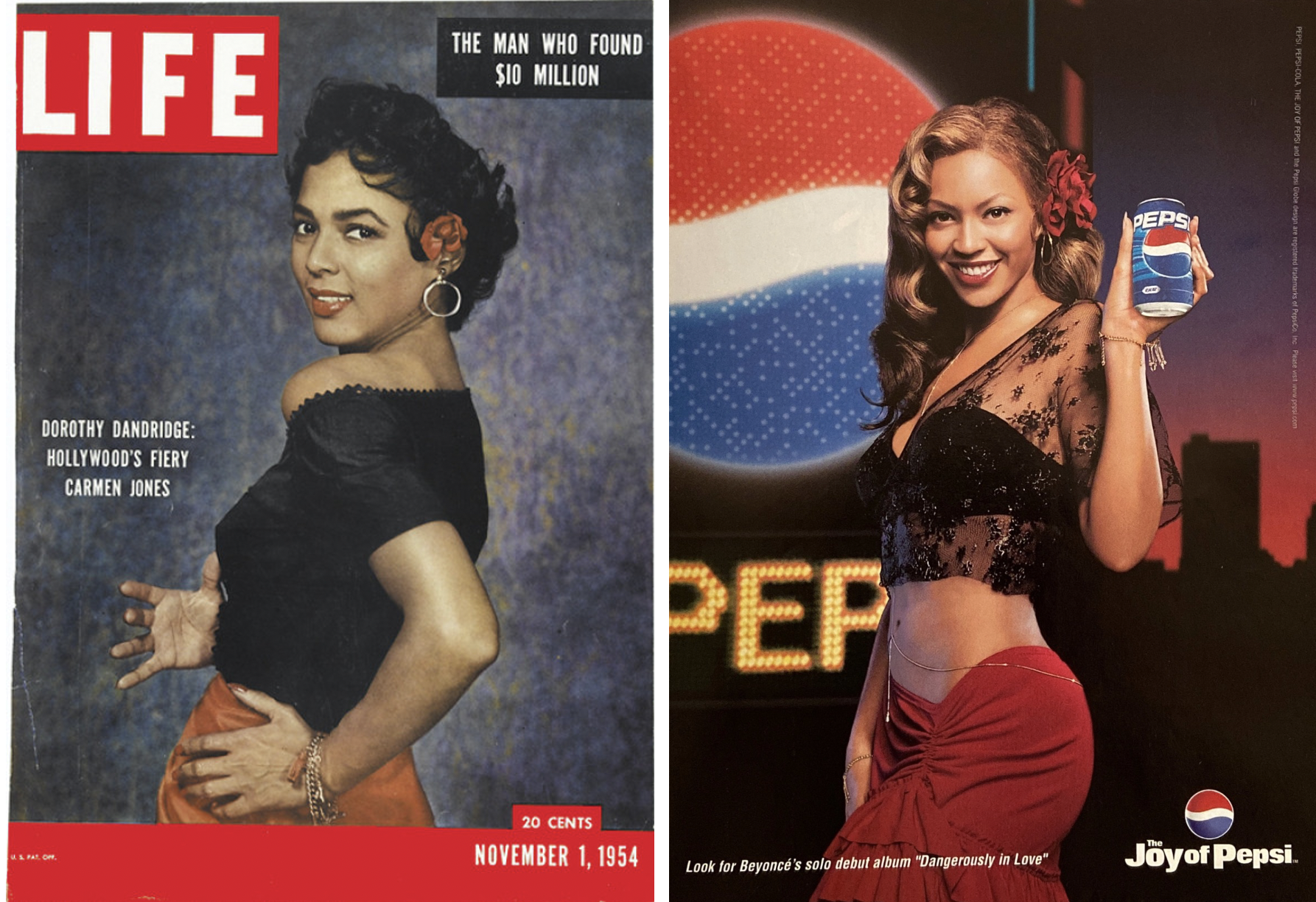
Dandridge, who died in 1965, had experienced a sort of cultural resurgence in Beyoncé’s teens; both Janet Jackson and Whitney Houston publicly hoped to play the actress in a film, but Halle Berry got her own project to the finish line first with HBO’s Introducing Dorothy Dandridge (1999).
Whatever the merits of Carmen or Beyoncé’s performance therein, it was admirable and perhaps ballsy for her to invoke Dandridge as she attempted to break into Hollywood. (She’ll do it again later in this chapter.) But it may also have been an understated example of something Beyoncé would do much more emphatically later on in her career, which is embed a history lesson in her work. The movie, the commercial, the eventual print campaign—all of it was an opportunity to mention the two performers at once.
That the now 20-year-old had also managed to cross paths with Lee, a cinematic legend all on his own, was just the icing.
Mathew Knowles planned to spend 2002 launching his clients’ debut solo projects—strategically staggered so that they wouldn’t “directly compete with each other,” as he told MTV News. Initially, his eldest daughter’s album was scheduled for that fall.
With solo stardom now officially on the horizon, Beyoncé would next appear as Foxxy Cleopatra, a composite of blaxploitation heroines from the genre’s heyday, in Jay Roach’s Austin Powers in Goldmember (2002). It was the third and splashiest entry in the franchise, and producer John Lyons had apparently been won over by her performance in Carmen, saying that “she lit up every frame of that project.”
I hadn’t realized before embarking on this series that Tina Knowles, costumer-in-chief of Destiny’s Child as well as Beyoncé’s mother, was the main overseer of her daughter’s film ventures during this period; in my research, it was always Ms. Tina vetting scripts, and accompanying her to auditions, and offering notes during production. “We sat down with Beyoncé and her mom on the rooftop patio outside of Mike Myers’s room at the Chateau Marmont and talked about the possibilities for [her] character,” Roach remembered in 2022. “Her mom was very much into blaxploitation movies … [She] was so cool and so helpful and instantly had ideas for us.”
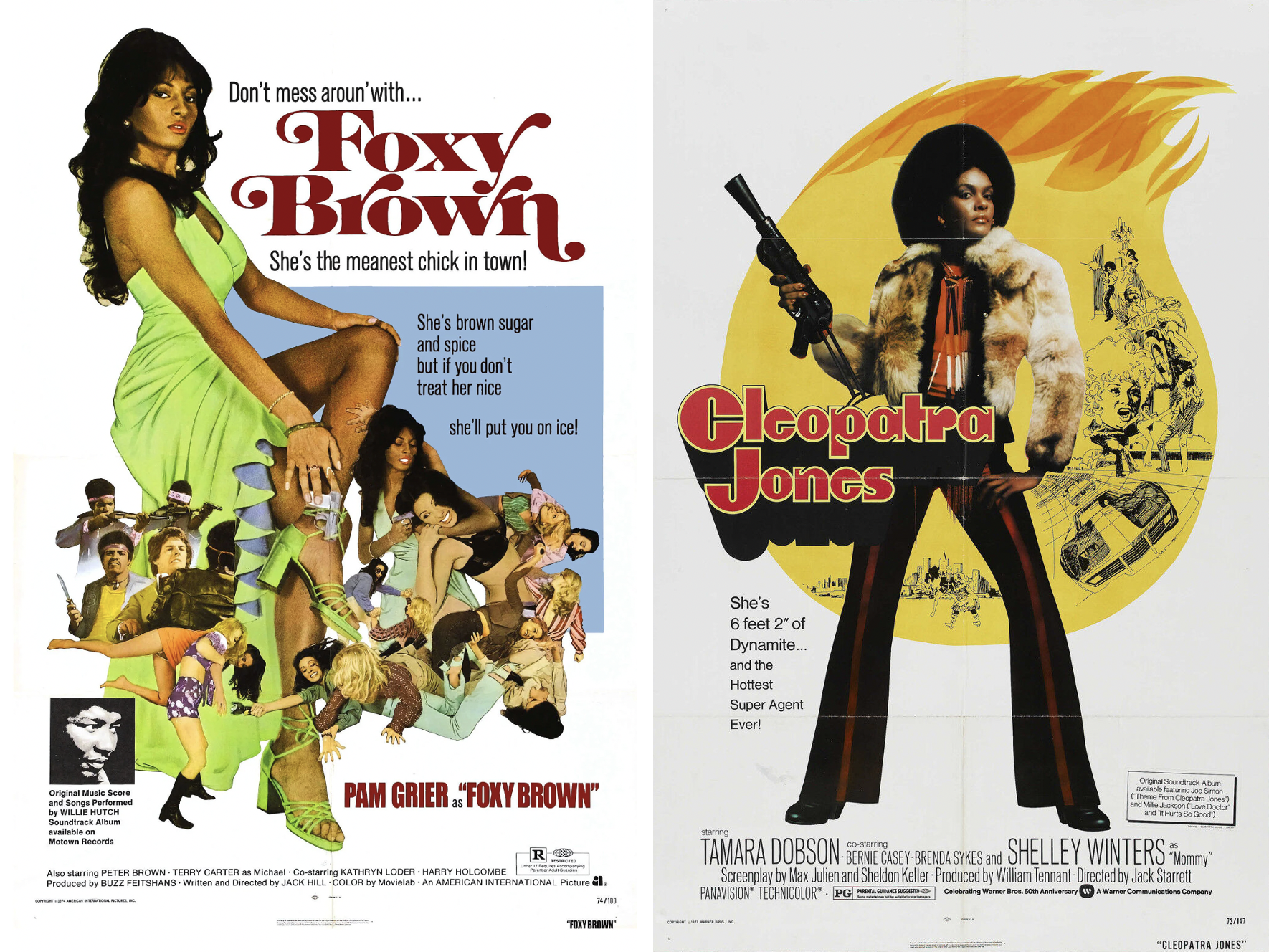
Foxxy Cleopatra—her name merging those of Pam Grier’s character in Foxy Brown (1974) and Tamara Dobson’s in Cleopatra Jones (1973)—is a former flame of Austin’s who helps him defeat Fat Bastard and take down Goldmember while thwarting Dr. Evil (all four men played by Myers). There was arguably another film-history lesson here if you were looking for one, and I’ve met many a Zillennial like myself—toddlers to preteens at the time of Goldmember’s release—for whom Foxxy was their first brush with the blaxploitation genre.
Whereas playing Carmen had been a gamble, Foxxy brought the exact spiritual and aesthetic puzzle pieces that Beyoncé hoped to fit together with her album. There was a huge difference in tone when she discussed the role, as when she writes in Soul Survivors (published after her work on the film but before its release):
I play another very sexy character, but at least she’s sweeter than Carmen … I talk real tough, just like the women in the black films from that era. I can relate a lot to her, because she’s really strong and sassy and she has got a lot of soul.
Beyoncé has described all but botching her first Goldmember audition, which would’ve happened in the second half of 2001. She apparently let her mom do most of the talking, read her lines far too straight, and told the room, “I don’t know if I’m all that funny.” She was called back anyway, and made sure everyone knew how much she appreciated it. “I went back in wearing a Pam Grier-like cat suit, an Afro wig and had memorized every blaxploitation film ever made,” she’d say. After landing the part, she and her cousin/all-around assistant Angie Beyince moved together into an L.A. penthouse, where the star is first thought to have started painting in her spare time.
A recurrence in Beyoncé’s comments about Goldmember is how kind and funny she found her colleagues as she worked outside of her usual industry. And again, there was a suggestion that there’d been something refreshing about her work environment: “Everybody has been really nice, and not fake nice,” she writes in Soul Survivors.
Luckily, the feeling seemed mutual. “There is no question that she is going to be a big movie star,” John Lyons said. “She holds the camera. She’s like Lucille Ball—she’s hugely funny. And she’s got that diva strength that will take her far.”
Goldmember would be a record-breaking box-office smash, and Foxxy arguably remains Beyoncé’s most accomplished comedic performance in a film. When the character reunites with Austin and tells him, “Mama only got a taste of honey, but she wanted the whole beehive,” it’s impossible not to hear it in the context of the star’s now millions-deep global fanbase. (It also only really clicked for me on this most recent watch that Dr. Evil performs a spoof of Jay-Z’s “Hard Knock Life [Ghetto Anthem]” [1998].)
All of that said, critics weren’t wrong when they pointed out the role’s limitations. “The movie doesn’t do much with [Foxxy] except assign her to look extremely good while standing next to Austin,” wrote Roger Ebert. A 2003 Elle profile of Beyoncé would suggest that her appearance was essentially a collection of reaction shots—“eighty-nine, by my count,” wrote Kevin Sessums. And as Jason King argues in the essay I cited earlier, “Roach, working with a minimum of creative imagination, cues Coffy [1973]-style wah-wah guitar whenever Foxxy Cleopatra enters the frame”:
It’s a constant reminder that Beyoncé’s skin color is her primary contribution to the proceedings. Though Goldmember never asks to be taken as a serious film, Foxxy Cleopatra is less a character than she is merely “the love interest,” which is to say “the sex object.” Cinematographer Pete Deming’s lens lingers on her curvaceous figure and she spits up stereotypical, neck-popping retorts like “You’ve got a lot of nerve dragging your jive, white ass in here.”
It’s worth saying, of course, that this is all knowing on the film’s part. As Beyoncé writes in Soul Survivors, “[Foxxy is] supposed to be over the top and exaggerated, sort of a caricature, which gives me license to overact.”
Ahead of the film’s release, Beyoncé noted that “as an actor, I get to follow in the footsteps of Elizabeth Hurley and Heather Graham [who’d played Austin’s first two love interests], and as a musician, I get to follow Madonna’s lead—she sang ‘Beautiful Stranger’ in the second movie.” Indeed, as with The Spy Who Shagged Me (1999), the Goldmember soundtrack was being released by the Madonna co-founded Maverick Records, with Beyoncé contributing two songs.
One was disco spoof “Hey Goldmember,” which she performs as Foxxy in the film, and the other was credits song “Work It Out,” a funk track initially doubling as the lead single for her album. The latter was given a flashy video tie-in by Matthew Rolston, who’s said that it was conceptualized as a tribute to ‘70s variety specials like The Sonny & Cher Show; legendary designer Bob Mackie sent over a bunch of archival looks from the era when he memorably dressed icons like Cher and Tina Turner.
But although “Work It Out” was a hit on various overseas charts, it didn’t do well enough domestically for Beyoncé to proceed with her plans; not only would it no longer be her lead single, her album would also be delayed to 2003 while she reconvened.
Michael Caine, who played Austin’s father Nigel in Goldmember, has said that one day while working on the film, he asked Beyoncé about her aspirations in life. “I want to win the Academy Award for acting,” she apparently replied.
This 2019 revelation would have been a scoop had the star not spent much of the 2000s vocalizing this dream herself; she mentioned it often in interviews, at one point even admitting to having a painting—whether it was done by herself, who knows—of an Oscar on her gym wall. “She’s determined to win an Oscar someday,” wrote Kevin Sessums in 2003, “but if her career does vanish, she would like to be an art teacher at a middle school.” Later, Beyoncé would say that she consciously took roles that put her in the company of Oscar winners—“so I have no choice but to pull up and really take it serious.”
“If you’re a singer, people just don’t want to give you a chance to prove that you can do anything else,” Beyoncé had written in Soul Survivors:
Diana Ross was incredible in “Mahogany.” People just want to scare you away from trying something new … Any kind of performance will help me to further develop my skills as an entertainer … The more I learn, the more I grow as a person and as an artist.
Later in 2002, rescuing her somewhat from the underperformance of “Work It Out,” Beyoncé was featured on Jay-Z’s “’03 Bonnie & Clyde,” the lead single from his newest album and an eventual top-ten hit. For the video, directed by Chris Robinson, the two artists portrayed themselves as outlaw couple Bonnie Parker and Clyde Barrow for a new millennium, with Beyoncé donning a beige beret similar to the one Faye Dunaway wears in Arthur Penn’s Bonnie and Clyde (1967). Jay-Z had reportedly seen the video in his head before the track had any lyrics, so inspired just by hearing the instrumental from producer Kanye West.
There’s a whole other series to be written about Jay-Z’s relationship with the film world—the video also begins with a slice of “Blueprint 2,” which samples Ennio Morricone’s The Good, the Bad and the Ugly (1966) score—but that relationship has many times intersected with Beyoncé’s beginning in 2002, whether you’d like to start here or with Dr. Evil’s take on “Hard Knock Life” months earlier. “’03 Bonnie & Clyde” tied their brands, fanbases, and myths together in a way that they’ve literally been expanding and capitalizing on ever since.
Only time would tell whether they were really together—evidence points to 2001 as the year they first started “trying to date,” and 2002 as the one they became serious—but in the meantime, they’d imbued the idea with some cinematic danger. He was the 32-year-old rap mogul who’d spun a troubled upbringing into an empire, and she the 21-year-old Southern belle with a freakish level of drive. If they were coming out as our new Bonnie and Clyde, then perhaps they expected to crash and burn at some point. Either way, they had newspapers to sell first.
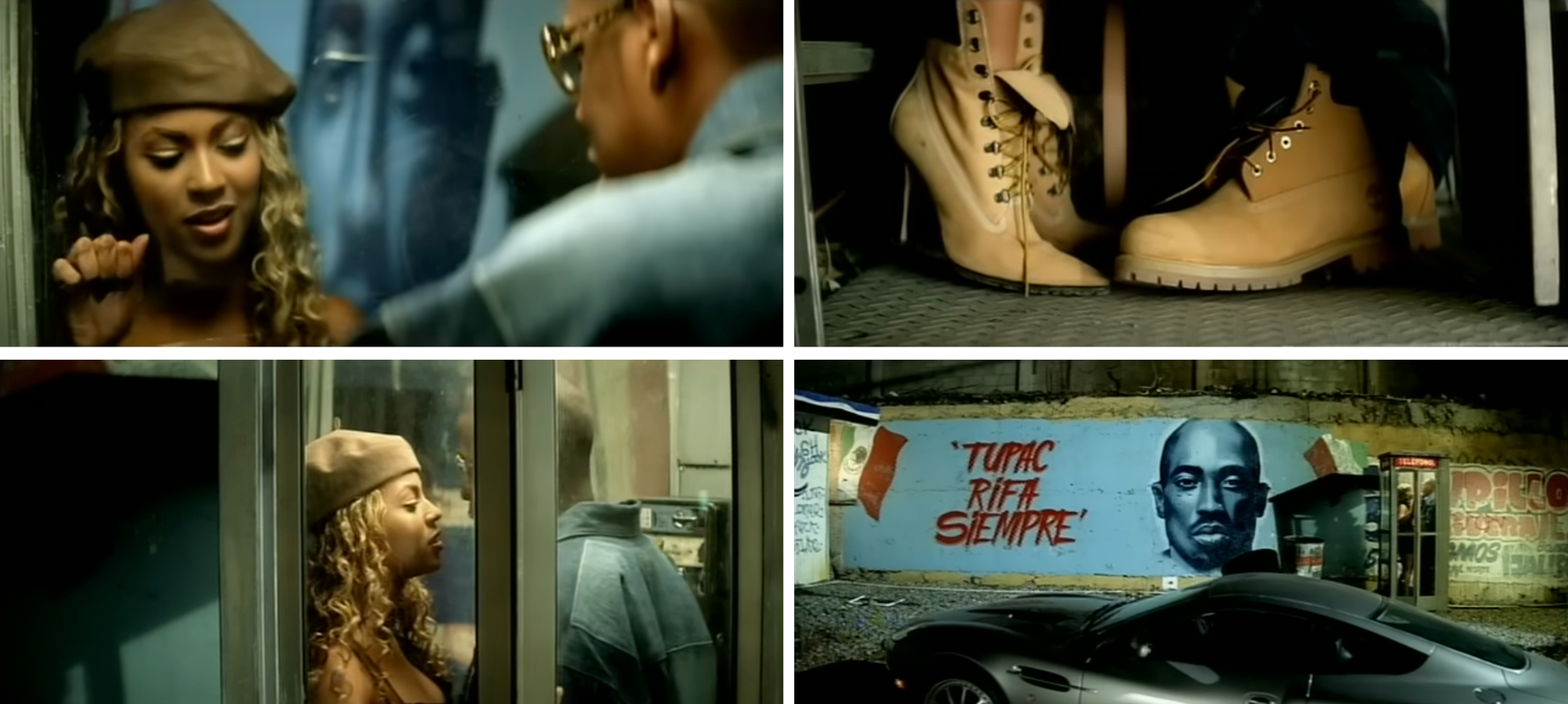
The video’s other main reference, however, was Tony Scott’s True Romance (1993), a film that Quentin Tarantino wrote and sold to help fund his debut feature, Reservoir Dogs (1992). Most directly and cheekily, Beyoncé and Jay-Z nod to the phonebooth sex scene from Scott’s film.
True Romance is another story about a couple on the run, though unlike Bonnie and Clyde—and notably given that Beyoncé and Jay-Z were beginning to test the waters as a public pair—there’s a happy ending for Clarence and Alabama Worley on the other side of all the destruction. In referencing these two distinct romantic crime films, it was almost like they’d kept both doors open as a way to pre-empt whatever was actually about to happen.
The next year, Beyoncé would be photographed by Rod Spicer for Ocean Drive dressed as Patricia Arquette’s Alabama Worley. Why exactly that was—and why they decided to go for a teary, despairing Alabama—seems to have remained only with those involved in the shoot.
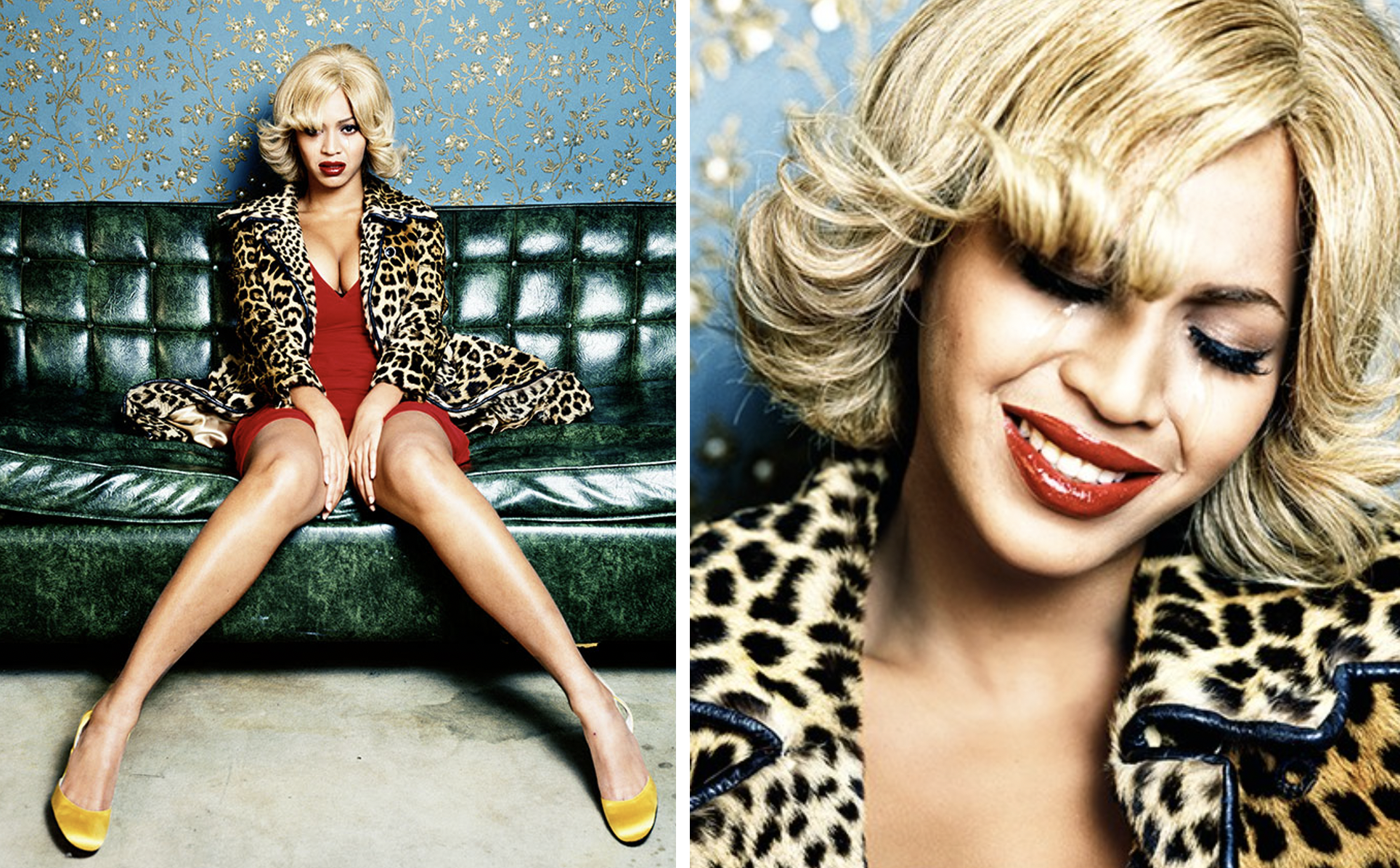
The nod indicated that she was still thinking about True Romance many months after “’03 Bonnie & Clyde.” But it’s also a great example of her knack for carrying artistic references across both mediums and time; the grand Beyoncé project has long been multi-disciplinary, but it’s also fascinatingly consistent when it comes to its proper nouns.
Beyoncé was the last member of the Destiny’s Child trio to release a solo album, which she did in June of 2003. Dangerously in Love was a collection of forward-thinking R&B, but with samples (Donna Summer, Shuggie Otis, etc.) and collaborations (Luther Vandross, etc.) that marked her as having an eye on her forebears. (She seems to have been introduced to Otis’s music on the set of Goldmember.) As always with the star, the past and the future had merged to meet her there.
A theme in Beyoncé quotes since the beginning of her career (as well as others’ about her) is the idea that she’s someone who thinks in pictures; she’ll hear a Stevie Nicks guitar riff and envision “a voluptuous woman” shimmying her chest, she’ll draw constantly on scrap paper as she explains herself in a meeting, and she’ll print out a bunch of photos of Daenerys Targaryen to have with her in the studio. In his 2019 book Ain’t I a Diva?, Kevin Allred notes that Dangerously in Love features a spoken track called “Beyoncé Interlude,” which goes as follows:
I believe that harmonies are colors
Every time I paint, it sharpens my harmony
Yesterday, I tried to paint you
But the colors weren’t beautiful enough
Your love goes beyond what I can say
Love, Beyoncé
For Allred, the interlude marks “a meaningful synesthetic marriage of music and visuals and [invites] a deeper analytic dive … into the visual aspect of her work.” We’ll be talking later about the idea of Beyoncé ‘seeing music,’ but this was an early example of her expressing that same concept in different words.
Dangerously in Love was supported by a superstar-making crop of videos—all but one of them (Johan Renck’s “Me, Myself and I” [2003]) directed by Jake Nava, one of the people Beyoncé has collaborated with most in her career. The real centrepiece would be the video that’s been rewritten to history as her first solo one, “Crazy in Love” (2003). She’d later say that she “wanted to be a female version of James Dean and wear an iconic white T-shirt and jean shorts,” the idea being that fans could easily assemble the look themselves.
For another of those early Nava videos, “Naughty Girl” (2004), Beyoncé enlisted Usher—a friend since her teens—to help her recreate a stretch of the climactic Cyd Charisse/Fred Astaire dance sequence from Vincente Minnelli’s The Band Wagon (1953). The musical had been particularly loved by Michael Jackson, who referenced scenes from it numerous times in his career—most famously in “Smooth Criminal” (1988), one of the videos that appears in Moonwalker. As a pair, “Crazy in Love” and “Naughty Girl” would win Beyoncé her first four solo VMAs.
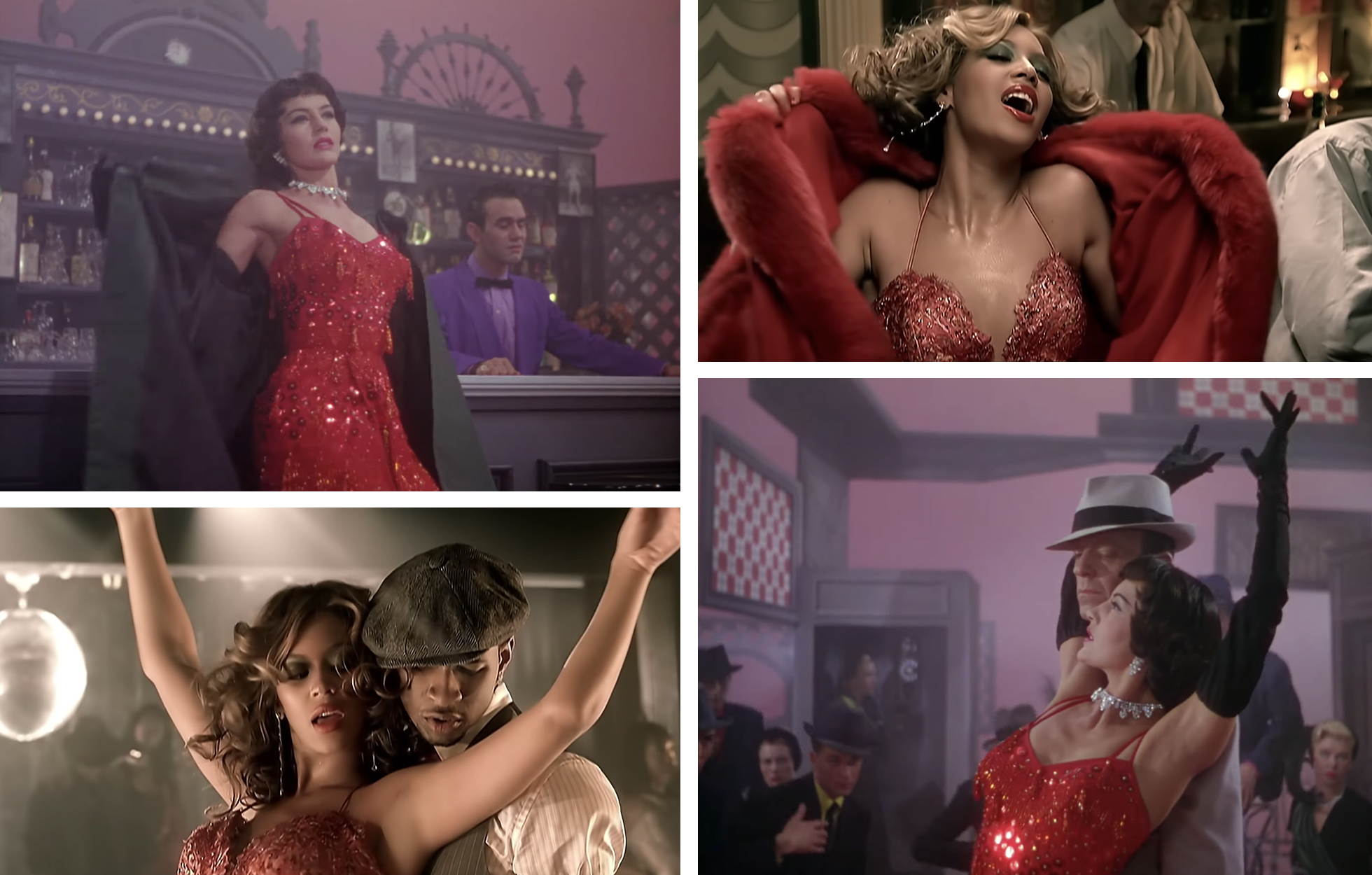
The star also participated in a short documentary about her album called The Making of Dangerously in Love (2003), for which I’ve never been able to find official credits. Over 15 minutes, she elaborates on certain songs through two different talking heads that we jump freely between. There’s split-screen so that this footage can sit directly alongside that of her in the studio—a sign that the short may have been made to send around to the big video networks, since this was a common quirk of shows like MTV’s Making the Video and BET’s Access Granted.
Seen at work with Beyoncé is Jay-Z, who strictly plays the role of fellow creative mind—he appeared thrice on the album if we account for “’03 Bonnie & Clyde” being included on international versions (and also co-wrote several other songs)—despite being her presumed boyfriend. In one of the short’s more quietly poetic shots, he’s reflected in the glass of the booth as his future wife layers her vocals on “That’s How You Like It.”
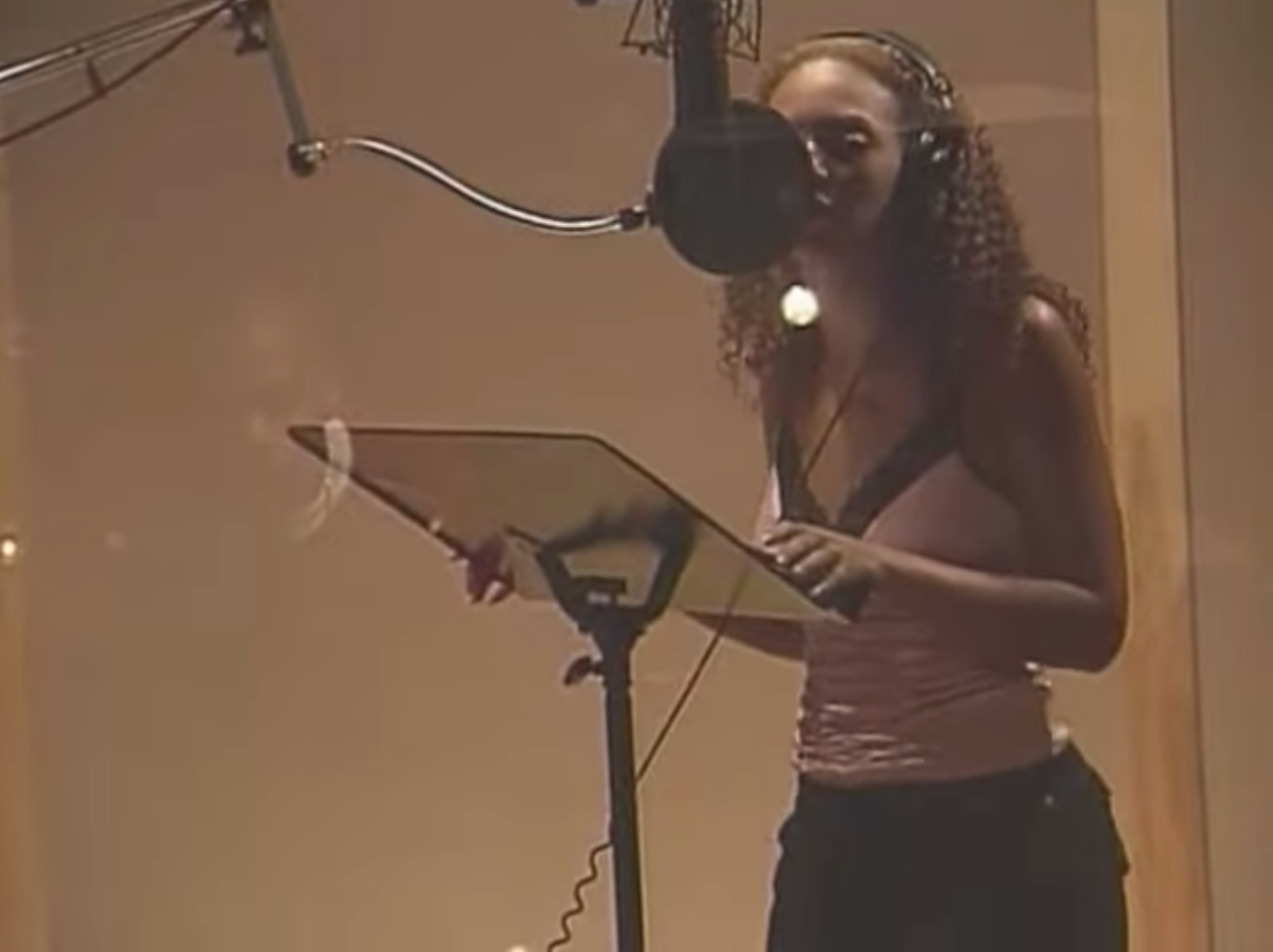
If you’re used to watching Beyoncé docs, where she’s typically both film subject and film orchestrator, you may notice here that she seems to fall more so into the former category than the latter. At one point, she jokes that she hopes people will make babies to her new music, then tells the camera, “No, don’t put that in there!” Regardless of how true this actually was, the implication is that she didn’t have final cut—and didn’t mind us thinking as much. There’s a felt change on this front that comes in 2006, a year Beyoncé will spend exercising and emphasizing her authorship.
As in some later films, though, we get a montage of photographs from her childhood (while “Me, Myself & I” plays—a slightly forced segue out of Beyoncé explaining that you can always depend on yourself in the face of romantic disappointment). In one of these, she and her parents pose in front of a house they lived in when she was a kid (on Rosedale Street, not Parkwood Drive). Others are of Beyoncé on the day that she competed in a Texas Sweethearts pageant—posing in front of the fireplace with her mom in one, and holding a trophy she won in another.
That year also saw Beyoncé star in another MTV movie, Jonathan Lynn’s The Fighting Temptations (2003). Acting opposite Cuba Gooding Jr., Beyoncé plays Lilly, a jazz singer who’s a local outcast in her small Southern town because she’s an unwed mother. (In the brief scene where she’s depicted as a child, she’s played by future protégée Chloe Bailey.) When Gooding’s Darrin, her childhood friend and a career grifter, needs to direct his hometown church choir in a gospel competition so that he can inherit $150,000, Lilly is the “Mary Magdalene” welcomed back into the community for her beautiful voice.
“She is misunderstood,” Beyoncé told Ocean Drive of the character. “She really is optimistic and just a warm woman with high morals who loves to sing … While I haven’t been through her life, ultimately I am a lot like [her].” Lilly is headstrong and self-sufficient—perhaps due to Beyoncé’s brand-spokeswoman status, she’s also a conspicuous Pepsi drinker—but she spends much of the film being simultaneously slut-shamed and leered at by other characters, in a way that gets tiring fast. “Again and again,” writes Tshepo Mokoena in her 2021 biography of Beyoncé, “her sex appeal sat at the core of her casting”:
Over the next few years, this fixation on her body’s curves, the cut of performance outfits and the thrust of her dancing would become a cross to bear. She did her best with both her limited acting experience and the (mostly) limiting ingénue characters into which she was meant to pour some life … She battled the ever-present dilemma for Black actresses: to be considered ‘real’ to Black audiences while marketable to white ones.
In the end, The Fighting Temptations made back its budget but not much more. Still, it was the first movie Beyoncé had been in that was about music, not to mention the most expressly Christian project she’d let herself be part of. So no matter how she felt about Lilly, the character was an excuse to sing jazz and church music and not have to pay a single thought to those genres’ commerciality. She sings spirituals like “Swing Low, Sweet Chariot,” and she’s introduced with a performance of “Fever,” a song that most people think of as Peggy Lee’s but was originally Little Willie John’s.
Yet again, there was also the suggestion that filmmaking filled some kind of void for Beyoncé: “Every time I do a movie I learn a little more about myself and about the work. And I always love the stability of making a movie, because I’m able to be in one place for a period of time. See, I’ve never really had that because I’m always traveling.”
As had been true of Carmen’s soundtrack, Mathew Knowles executive produced the one for The Fighting Temptations and eventually co-released it through Music World Entertainment, his company that now managed Kelly, Michelle, and his two daughters as solo acts. But the arrangement this time seemed somewhat upgraded: “[Mathew] negotiated the soundtrack deal with Paramount as conditional to Beyoncé taking a lead role in the film,” reported Billboard, quoting the manager/father as saying, “Music World/Sony had to have the soundtrack, and Beyoncé had to be the soundtrack’s lead artist; that was the deal-breaker.”
Included on the album were two Beyoncé songs—both released as singles in 2003—that aren’t sung as Lilly in the film. The bigger hit was “Summertime,” a collaboration with the artist then known as P. Diddy. (It was one of three tracks she’d later be seen performing in Fade to Black [2004], Patrick Paulson and Michael John Warren’s documentary about Jay-Z.) But more fun and useful to me is “Fighting Temptation” with Missy Elliott, MC Lyte, and Free. In the video, helmed by Antti J., one of Beyoncé’s set-ups has her in an apartment that’s decked out in blaxploitation posters. The two films from which Foxxy took her name are represented, but so are genre classics like Shaft (1971) and Detroit 9000 (1973).
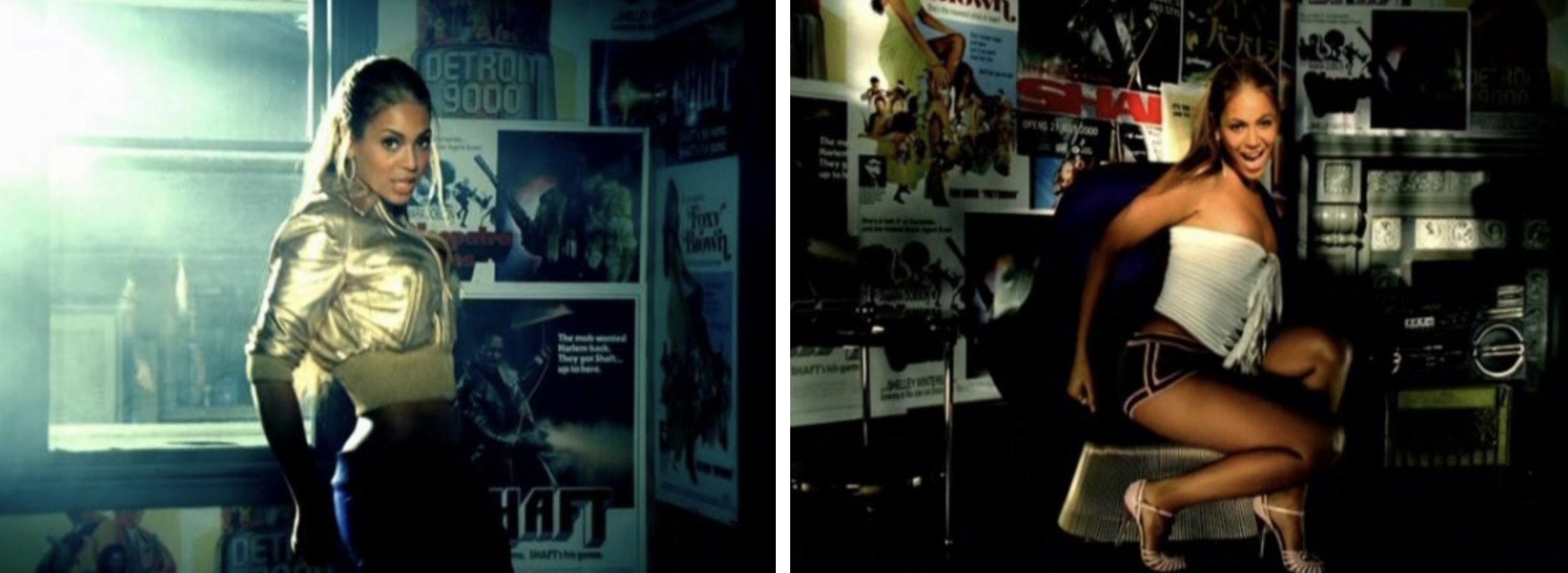
An idea I’ve been trying to convey so far is that Beyoncé doesn’t typically one-off reference things so much as create threads to return to later, whether that means weeks or years or decades. You can take basically any project of hers from the fourth chapter of this series and find the bones of it somewhere in this first one. So if you end up reading all four, the same proper nouns will keep coming back—almost like Beyoncé has carried every spool of thread with her in a big suitcase that she opens back up whenever she embarks on a new project. (Even Usher cameos in The Fighting Temptations via an episode of Cribs, though that would’ve had more to do with the MTV connection.)
The 2004 Grammys would be a prime example of the many connected dots of Beyoncé’s life. That February evening, she tied with Jay-Z, OutKast, and Pharrell for the most nominations at the show (six apiece), and ultimately went home with the most awards of anyone (five). But the statuettes themselves feel borderline secondary to other things that happened that night.
At the top of the broadcast, the star was brought out by Prince to help him perform some greatest hits; the two even built “Crazy in Love” into the medley. She then won the first award of the night: Best Contemporary R&B Album, presented to her by Gwen Stefani and none other than Quentin Tarantino, with both presenters kissing her on the cheek.
Beyoncé’s four other wins would not be televised, but she eventually came back out for a second performance—this time of her album’s title track, which she sang as one of many characters in a moving painting... after being introduced by Cuba Gooding Jr. See what I mean?
The previous fall, Beyoncé had taken Dangerously in Love on the Europe-only Dangerously in Love Tour, her first as a solo headliner. The tour funnelled the album through a decidedly old-school showbiz lens—think lots of sequins and feathers, Michael Jackson-esque references to Bob Fosse, and Beyoncé entering the stage more than once from the ceiling. Included on the setlist were several songs associated with her film appearances thus far, including “Work It Out,” “Fever,” and “Summertime.”
One of the tour’s London stops was recorded and eventually released as the concert film Live at Wembley (2004), directed by Julia Knowles (no relation, to my knowledge). The film, which premiered at various American theatres in April of 2004 before hitting home video, marked the very first solo Beyoncé DVD release.
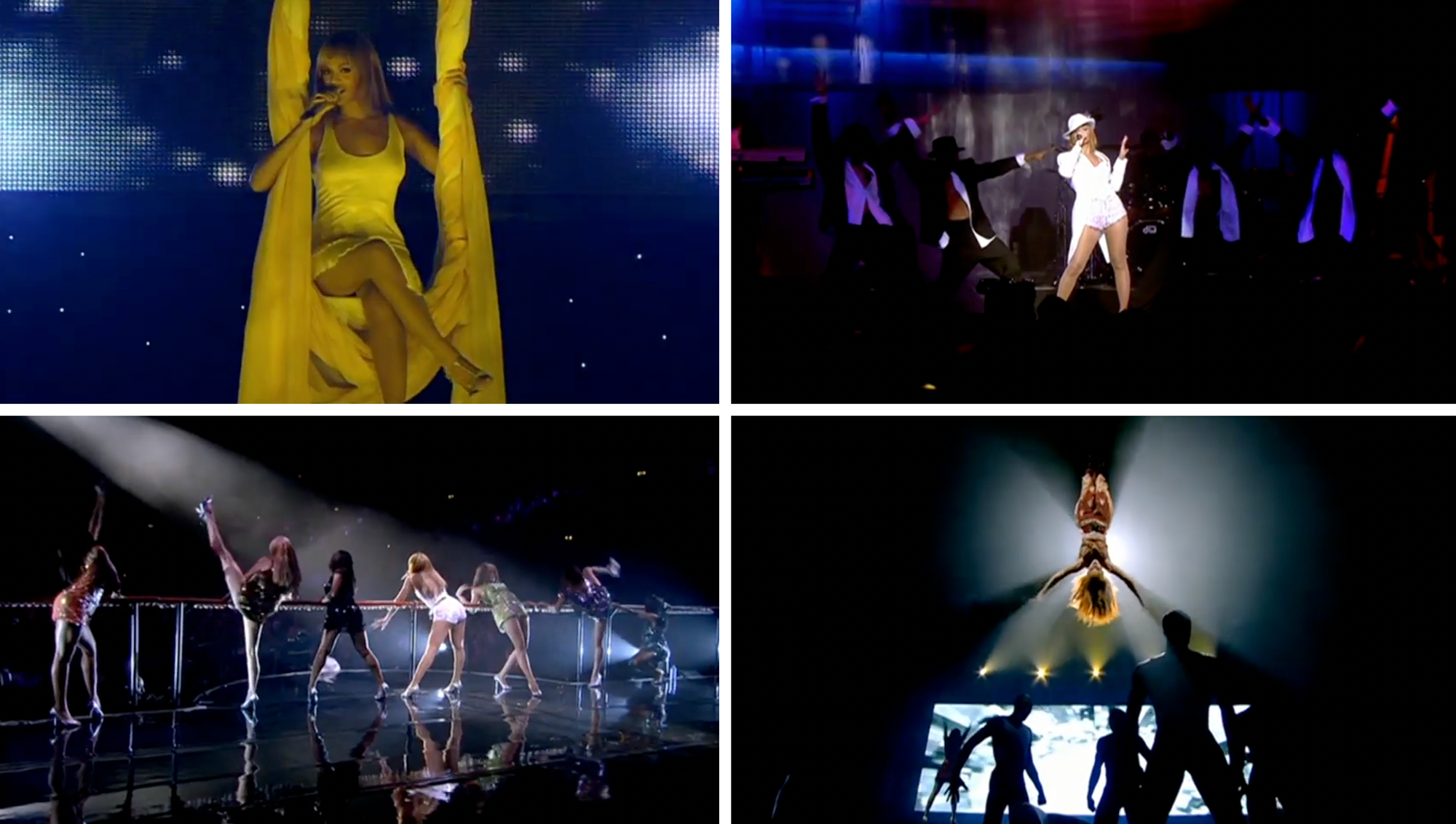
Like the album, the tour saw her straddling two different moments—clearly trying to get the solo ball rolling, but still an active and respectful member of Destiny’s Child. So after more than an hour of showcasing her superstar potential, Live at Wembley ends with Beyoncé telling the crowd they can expect a new album from the group the next year. (They’d indeed release their final one in 2004, with its associated concert film directed by the same Julia Knowles.)
Nevertheless, the solo ball was steadily being rolled. Live at Wembley came with a set of 11 bonus clips collectively titled VIP Admittance (2004)—most of them doc segments on specific aspects of the tour, called things like “Beyoncé’s Dressing Room” and “Meet the Fans.” The star is the main talking head, but she’s joined by a couple of names that would become staples in her cinematic universe, including musical director Kim Burse and choreographer Frank Gatson Jr., who both met her as a teenager.
In one of these clips, Beyoncé explains that she and Frank—who calls her “our Black Ginger Rogers”—love watching musicals and picking out numbers they’d like to recreate; she name-checks There’s No Business Like Show Business (1954) as well as Fosse’s Sweet Charity (1969), their reference for the show’s “Yes” sequence. (And in case you were wondering, Gatson had co-choreographed the “Naughty Girl” video.)

In another segment, she tells us that she’s been working for two weeks straight without a day off, and how that’s not ideal for her vocal health—again, one of those rhetorical things where she betrays a lack of control. In yet another, she’s asked a series of random questions and says that she’d hope to have all her paint supplies with her on a desert island. From the beginning, her DVDs provided fans with both an all-access pass to her work ethic and an opportunity to learn something rare about her.
The next month, Beyoncé started filming her scenes as pop star Xania in Shawn Levy’s The Pink Panther (2006), co-starring Steve Martin as the rebooted Inspector Clouseau. The film was initially scheduled for the summer of 2005.
Eventually, the star would record two songs for it: “A Woman Like Me,” which she performs as Xania during the climax, and “Check On It,” which appears in the credits. Mathew Knowles suggested to Billboard that they’d strategically taken the part—relatively minor, not to mention one of his daughter’s least memorable or interesting—to ensure that audiences wouldn’t “go two years without seeing a Beyoncé movie.”
But for anyone who may have taken that casting news as unpromising, Beyoncé HQ made a fascinating play to endear her to “serious” “cinephiles” in the new year.
At the 2005 Oscars, the same night that she and Jay-Z made one of their first arm-in-arm red carpet appearances, Beyoncé performed three out of five Best Original Song nominees despite not having anything to do with them. As Lisa Robinson would later write in Vanity Fair, “It seemed as if she had more airtime than host Chris Rock.”
“I can’t believe I’m here,” Beyoncé had told Star Jones upon arrival. “It’s so surreal to me … I’m not worthy.”
“I don’t know why you would say you’re not worthy,” Jones responds in the clip. “Do you know what I said to someone the first time I saw you perform? I actually said, ‘This is how people must have felt the first time they saw Diana Ross.’”
The Mahogany superfan is visibly touched by the compliment; stories abound of her and her girl groupmates studying tapes of Motown acts before they were signed, and Destiny’s Child had fielded numerous Supremes comparisons for reasons both good and bad. But neither Beyoncé nor Jones could have known how prescient it was as far as the star’s next big movie.
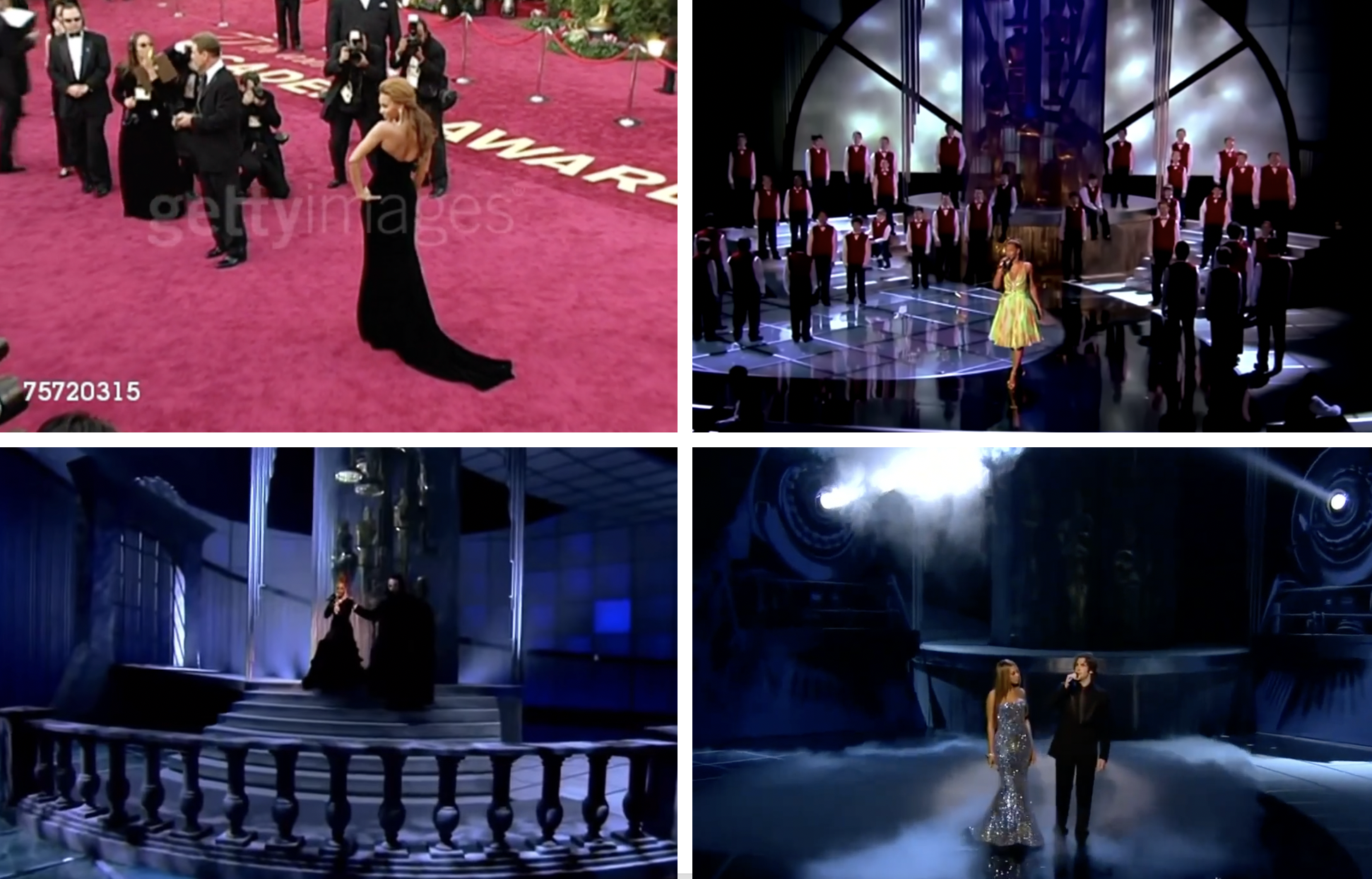
That night, with nominee Andrew Lloyd Webber on the piano—and with an actual Phantom guiding her down a set of stairs—she performed the devastating “Learn to Be Lonely” from The Phantom of the Opera (2004). With the American Boychoir, she did her best with the French-language “Vois sur ton chemin” from The Chorus (2004). And in a duet with Josh Groban, himself not nominated despite contributing the song to its soundtrack (an interesting foreshadow), she sang “Believe” from The Polar Express (2004).
Just two months after Star Jones told Beyoncé that she was reminiscent of a young Diana Ross, the 23-year-old was reported to be in talks to appear in Bill Condon’s Dreamgirls (2006), the film adaptation of the Broadway musical loosely based on the story of Motown and especially the Supremes. The film was set to begin rehearsals shortly after Destiny’s Child finished touring their final album in late 2005.
In a wild bit of casting, Beyoncé would be playing Ross stand-in Deena Jones, member of the Dreams whose rise to stardom comes easiest—and partly through the machinations of her overbearing manager/husband, Curtis (Jamie Foxx). But lest anyone think the role had been handed to her, a 2007 Vanity Fair piece describes a Condon who was skeptical all the way until her screen test.
When Beyoncé was told that she just needed to sing with the piano, she replied, “No, no, actually, I’ve been watching girl-group tapes over the weekend, so I have some moves for you.” As she’d explain while promoting the film, “I looked at every Cher video, Barbra Streisand, and of course Diana Ross and the Supremes.” Producer Larry Mark called the screen test “thrilling to watch, because she had absolutely done her homework.”
If I’ve been discussing the star’s early movie roles in terms of risk, then Deena was by far the biggest one she’d taken. “Beyoncé has lived a lot of Deena Jones’s story already,” Condon would say, “having grown up as a teenager with a girl group and then emerged into the spotlight on her own.” Press coverage tended to get into other parallels—perceived synergy between Curtis and Mathew Knowles, for one, and also that the musical begins with the Dreams losing a talent competition, which Beyoncé and her group had done on Star Search in the early ’90s.
“Some of the things parallel, but really it’s nothing like my life,” she’d insist, trying to start a whole new conversation about divadom being not the picture-perfect movie everyone would’ve saw. “When people think of dreams, they only think of the beautiful, shiny things,” Beyoncé said. “They don’t think about the sacrifice and the prices that ... come along with success.”
Playing Deena was a risk that the star wasn’t just willing to take but desperate to. She believed that she and co-star Jennifer Hudson—making her film debut as Effie White, the Dreams member who’s less marketable than Deena but actually has the juice—were destined to be part of the project because they were both born in late 1981, exactly when the musical premiered. Beyoncé would also share that when she first met Frank Gatson a decade prior, he’d simply told her, “Deena Jones. Dreamgirls … Go get the soundtrack.”
There were clearly emotional stakes to her involvement that had not existed with, say, Goldmember. Adding to that was how Condon’s film had spent substantial time in development hell, with previous would-be Deenas including two artists Beyoncé deeply admired, Whitney Houston and Lauryn Hill. “I’ve never wanted anything so bad,” she’d say, declaring it the first movie she “would have been just torn apart” not to land a role in.
Dreamgirls was finally being made due to the success of Chicago (2002), the first musical to win Best Picture in three and a half decades; Condon had been nominated for an Oscar for adapting its screenplay. “When I watched the movie Chicago, I wanted to cry,” Beyoncé explained just before rehearsing her scenes as Deena. “It was the first musical I saw since the old musicals, and I was just so excited. I was like, They’re coming back!”
(And because there’s usually an Usher connection: he’d also been in talks to star in Dreamgirls as Effie’s brother C.C.—eventually played by Keith Robinson instead—but was ultimately too busy. Bringing this fun fact full circle, he’d make his Broadway debut in Chicago in 2006.)
Throwing a wrench in the narrative of this sophisticated Hollywood turn, The Pink Panther was delayed half a year to early 2006 after the first cut apparently came in too raunchy. That’s how Beyoncé found herself making a video for “Check On It” in late 2005 after back-to-back weeks playing around as Deena, a switch that she told MTV’s cameras she found tricky.
For the first time in a video capacity, she was getting to work with industry heavyweight Hype Williams, who’ll come up again later. Aside from everything in the video being pink, there’s no onscreen indication that “Check On It” was recorded for The Pink Panther—at least not in the version that Beyoncé has chosen to immortalize on YouTube (a different cut, which built in clips from the movie, was circulated at the time). It doubled as promo for Destiny’s Child’s new compilation album, #1’s (2005), serving as the second single despite being a solo endeavour of Beyoncé’s—a move that one could argue smacked of Deena Jones.
There are two other things to highlight about “Check On It” for our purposes. One is that Beyoncé tells MTV of her Pink Panther character, “She’s very glamorous, she’s like a modern-day Josephine Baker.” She doesn’t elaborate on what she means by this; like ’20s film star Baker, Xania is an American who gets to do some romping around Paris, but Inspector Clouseau also suspects that she’s hiding something for much of the film (and I’ll never miss an opportunity to tell people that Baker was a literal spy). In any case, this is our first mention of a very important proper noun.
And here’s the second thing to say about “Check On It,” which arguably has greater implications. Sometime in the past year or so, Beyoncé had crossed paths with an Englishman named Ed Burke. “I was working in an art studio for a crazy artist who’s basically documented his life, his shop, for 30 years,” he’d later explain. “And then a friend of the family called me up and said, ‘Do you want to work for me?’ I said, ‘Yeah, sure,’ He said, ‘Go pick up a camera. You are shooting Beyoncé.’ Never heard of her.”
Burke soon became her full-time videographer nonetheless, shooting anything and everything she got up to professionally—rehearsing choreography, or making a surprise appearance, or talking shop with one of her parents. “She’s smart, because she realized the value of owning her own footage,” Burke would say. “So I ended up shooting everything. It was like this for 16 hours a day.”
Said realization was supposedly rooted in a specific moment, which Burke has dated to 2005. When Beyoncé asked MTV for some B-roll that had been shot for Making the Video—and if he’s good with his dates, then we’re likely talking about “Check On It,” the only solo video she released that year—the conglomerate asked her to pay up. “But it’s my image,” Beyoncé said within earshot of her videographer, clearly having an epiphany about media licensing and, one assumes, her future.
Principal photography on Dreamgirls began in January of 2006. “Every day, I wrote emotional diaries, and I worked with an acting coach, and I had to go through the most painful memories in my life,” Beyoncé would later remember:
Whatever the emotion was in the scene, I had to find those emotions in my life. So it was very much like therapy, and very difficult, and I mean literally crying for hours and hours. And when it was time for me to cry onscreen, it was so real, and so true to my heart. I think people are gonna be shocked because I *can* call myself an actor now.
The whole experience seemed more than a little taxing, but Beyoncé considered this more a feature than a bug. “I’m happy I had to work this hard for it because it feels that much better when you see the finished results,” she’d say, adding elsewhere, “I just want to challenge myself and learn, and I admire people like Barbra Streisand and Diana Ross who took that risk and are really good at it.”
The star had apparently made her Dreamgirls trailer into a sort of Ross “shrine,” where she watched Mahogany and Lady Sings the Blues (1972)—the Billie Holiday biopic that earned Ross a Best Actress nomination—“over and over again.”
At least some of the stress of Dreamgirls was totally self-inflicted.
Closer to this time, press surrounding Beyoncé’s film roles tended to highlight whatever physical changes she’d undergone in order to play them. That was partly because her body was—as it still is—something people wanted to talk about ad nauseum, but it was also because she kept the topic on the table; you’d never squeeze much out of her inquiring about (for example) Jay-Z, but anything under the circa-2000s diet culture umbrella seemed fair game. The first time I noticed this in the context of a movie was with Goldmember, for which Beyoncé maintained a regimen that she’d call “no picnic” in Soul Survivors.
For Dreamgirls, Beyoncé—not Condon, who reportedly had reservations about the idea—wanted Deena to have visibly lost weight when the film jumps forward a decade. “I wanted it to be something more than just make-up and hair. I wanted to see the change,” she said, adding that she was inspired by both Tom Hanks’s efforts while making Cast Away (2000)—a film about a man stranded on a desert island—and by Diana Ross’s actual physique—the result of an eating disorder—in the ’60s and ’70s.
Beyoncé’s extreme diet is mentioned over and over when you read about Dreamgirls, generally written up in a way that we’d now consider journalistically irresponsible. “For this movie, I was willing to do anything,” she explained, saying that she found it helpful as an actress to not recognize herself in the mirror. “It was a sacrifice. Definitely a sacrifice, and it was difficult on the set.”
We’ll be talking more later about how the star has often equated bodily suffering with commitment to her craft—just go with it for now. But it’s also true that so has the Academy of Motion Picture Arts and Sciences, with its extensive and semi-ridiculous history of bestowing awards upon actors who’ve starved, frozen, bled, made themselves unrecognizable through prosthetics, or lost themselves to a role in some other tangible way. (Hanks had been nominated for an Oscar for Cast Away.) So one imagines that with Beyoncé, who openly chased an Oscar during this period, you can’t explain away 100% of her behaviour with the evils of aughts culture or the basic fact of being a public figure.
While Dreamgirls was coming together, February finally saw the release of The Pink Panther. Beyoncé isn’t in as much of it as its marketing would suggest—something that hadn’t been all that untrue of The Fighting Temptations, either.
As in Goldmember, her job as Xania is mostly to appear sexy and collected while legacy comedians do batshit things around her, though she does get to kiss Jason Statham in the first several minutes. (An additional bit of trivia is that the “Overture” from Bizet’s Carmen plays at one point, because why not.) That said, the film grossed twice its $80 million budget, so if nothing else, Beyoncé could now claim to have helped make multiple studios a hell of a lot of money.
When production wrapped on Dreamgirls in April, she immediately got to work on her next big project. “I was supposed to be taking a vacation,” she’d explain. “And I said … I don’t know how to relax, I might as well go into the studio.”
As Beyoncé told the story of her second album, B’Day (2006), it was recorded in just a couple of weeks—crucially, without her dad’s knowledge or creative involvement—using all the pent-up energy she’d amassed playing Deena. “I had this big, aggressive record after Dreamgirls because I was in this cage,” she’d say years later, “and I needed to get all of this emotion out, because that character was living inside of me.”
Adding to the sense of repression was how Condon had been happier with her performance as Deena the less powerfully she sang. “She was very passive, and everything she did was really, really subtle,” Beyoncé explained of the character to Vanity Fair. “Vocally, I had to completely hold back. I had to whisper things—I couldn’t sing anything in my full voice.”
Able to sing as loud as she wanted again, she did: B’Day is a brassy, moody, and famously booming collection of songs, at once full of braggadocio and largely written from the perspective of a woman scorned. “I wanted to do different things, to be innovative and kick really hard beats,” Beyoncé said. “I think I would have been scared to take that risk if I hadn’t done [Dreamgirls]. I would have made a love album, because that’s where I am in my life. The movie inspired something else that’s not in me. Or I guess it is, somewhere.”
Included on the project, set for release on her birthday in September, was a spoken track called “Encore for the Fans,” where she called it the “film of [her] life.”
Long before its premiere, the Dreamgirls team did everything they could to set the film up for a successful awards run. That included hosting a 20-minute press preview of certain numbers at Cannes in May, where Beyoncé was among those in attendance on the Croisette.
“[Condon] has reworked much of the musical’s second act,” wrote Gregg Kilday after the event, “introducing plot lines like Foxx’s character trying to shape Knowles’ lead singer into a movie star a la Berry Gordy’s efforts to enshrine Diana Ross in celluloid.” In other words, Dreamgirls would be making a nod to Mahogany, the critically derided movie that Beyoncé had been mentioning constantly since 2002.
Already, though, there was chatter that the real standout performance in the film was Jennifer Hudson’s, and a bit of a press-manufactured feud between the two women started to emerge. “Producers plan to separate the film Dreamdivas at the Oscars, demoting Hudson to supporting because Beyoncé has more screen time,” reported the L.A. Times. “And, well, probably just because she’s Beyoncé. But how ironic considering that’s exactly what Beyoncé’s character does to Hudson’s in the ‘Dreamgirls’ story: knocks her out of the lead role!”
The videos for B’Day’s first two singles would be helmed by esteemed director Sophie Muller, marking the first time Beyoncé had collaborated with a woman director as a solo artist. (Destiny’s Child had made two videos, “8 Days of Christmas” [2001] and—funny enough—“Nasty Girl” [2002], with Sanaa Hamri.)
When Beyoncé hired Muller, she was best known for her work with Sade, Eurythmics (plus Annie Lennox working solo), and No Doubt (plus Gwen Stefani working solo); just in the year leading up to B’Day, she’d directed both “Cool” (2005) and “Hips Don’t Lie” (2006). “I chose Sophie because her videos are cinematic, and they literally feel like short films,” Beyoncé said. For me, Muller’s presence adds an interesting dynamic to the specific ones she made for the album, both sexually provocative but in ways that felt somehow more purposeful, more grown-up, and maybe a tad more alienating than Beyoncé’s previous work. “I wanted to use a woman because I wanted to have a different approach,” the star explained, “and I wanted to be sexy, but from a different point of view.”
Their first collaboration was “Déjà Vu” (2006), a video that took the ethos of “Crazy in Love” to a new extreme. Beyoncé had asked Muller to fly to Louisiana, from which Ms. Tina’s side of the family hailed. “We shot this in New Orleans right after Hurricane Katrina,” Beyoncé would say, “and the choreography is almost tribal in my mind”:
There’s something spiritual about Louisiana, where my family is from, and I thought of Josephine Baker. She had a way of dancing that was almost possessed. I used her as a reference and combined her with Brigitte Bardot … They both had that French influence, which is really strong in Louisiana.
The Beyoncé of “Déjà Vu” is so tormented by thoughts of her man that we’re practically incidental as viewers, let in on the performance but not who it’s addressed to. (The video’s sweaty onscreen activity with Jay-Z was poorly received by some fans at the time, resulting in an infamous petition demanding a reshoot; the same petition found Beyoncé’s dancing “erratic, confusing and alarming at times.”) But she also conjures up numerous ghosts in the video, both by ‘invoking a deserted antebellum South’—as Kevin Allred unpacks at length in Ain’t I a Diva?—and through Baker, now regularly being name-checked by Beyoncé as she rolled out B’Day.
In 2002, Destiny’s Child had wordlessly nodded to Baker on their first world tour, and the reference in “Déjà Vu” was similarly more implicit than anything. But when the star performed the song at Fashion Rocks that summer, she turned it explicit for anyone who hadn’t been following B’Day’s promo tour.
“Beyoncé enters the scene, thrusting her hips with her arms high above her head, wearing a version of Baker’s banana skirt,” scholar Terri Francis summarized of the performance, in an article for The Scholar & Feminist Online:
Beyoncé performs a direct quotation of Baker’s famous banana dance … The historical reference contextualizes Beyoncé’s erotic dancing, which includes thrusting her derriere powerfully and circling her hips slowly while she tosses her hair and, adding a comic touch, clicks her neck from side to side. After a segment where she dances and sings with the clouds covering her waist, she stands to dance, and screens behind her rise to reveal a well-known image of Baker’s face.
This was arguably the era when the academy—with a small A, that is—truly started to engage with the star’s art. As Francis wrote, “Beyoncé, dismissible as pop/hip-hop silliness in many scholarly quarters, seeks, it seems, greater significance and ownership of her own work by claiming Baker and enacting a researched performance.”
Less academically studied but still film-inspired was “Ring the Alarm” (2006), the second of Muller’s B’Day videos. The song’s narrator fears that her man is cheating but, hilariously, expresses that mostly as a list of luxuries (chinchilla coats, a penthouse off the coast, etc.) she knows the other woman will soon get to enjoy. Beyoncé’s character in the video has seemingly already committed some unspeakable crime when we meet her—whether against her man or this other woman, it’s unclear—and is arrested, interrogated, and tried.
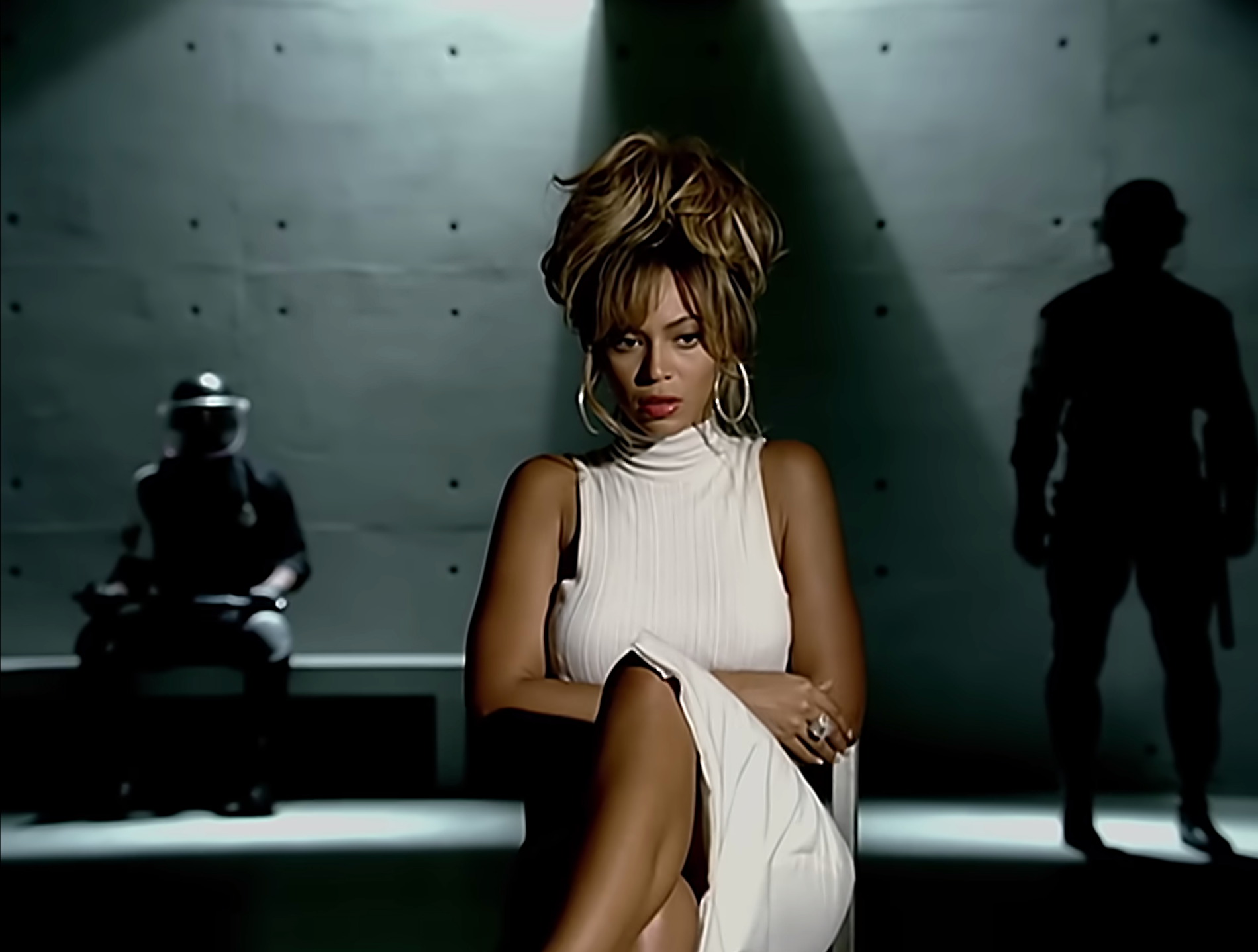
The main reference for “Ring the Alarm” is Paul Verhoeven’s Basic Instinct (1992), a film about the murder investigation for a rock star who was stabbed, mid-sex, with an ice pick. (Naturally, all of this—especially in the context of the rest of B’Day’s lyrics—raised brows regarding Beyoncé’s relationship with Jay-Z.)
The star would later connect the video to her work on Dreamgirls—“the first movie I’ve really acted in,” as she said. “I put six months aside [for the film], worked with a coach for two months. And that carried through to my music. I treated the video … like a movie scene.” Most audacious is the reference to Basic Instinct’s notorious interrogation sequence, which Beyoncé recreates without quite, you know, recreating.
Beginning around B’Day, Beyoncé’s team started to produce more compelling and ostensibly candid behind-the-scenes material. Ahead of the album’s release, for instance, there were multiple teasers that showed her putting its music and early visuals together, the footage largely fly-on-the-wall and quite personal. We see her in the studio cuddling her Shih Tzu as well as her nephew, Julez, and the voiceover sounds less like it originated from a formal interview and more like it was decoupled from a video file of Beyoncé speaking to someone casually.
All of this was presumably fuelled by a pair of developments in Beyoncé’s life. One was obviously that she now had Ed Burke on her payroll, getting the kind of coverage that might include videography gold by default.
The other development—less relevant to the teasers mentioned above, but extremely relevant to projects discussed later in this chapter and beyond—is that Apple had earlier that year begun selling MacBooks, the company’s first laptop to come with a built-in camera. That theoretically made it easier than ever for the star to be her own videographer if Burke wasn’t around (or if she didn’t want him around), to prop her computer up somewhere and simply hit record.
“Here’s the way it works now,” Amy Wallace would write years later, in an excised bit of a GQ profile of Beyoncé. “If MTV or Access Hollywood or anyone else wants some footage of Beyoncé and Beyoncé thinks it’s a good idea, Burke shoots it and lets them borrow it.” It was starting with the B’Day era that you started to see evidence of this whenever the star partnered with a media third party; more often than not, any doc footage had generally been shot—and was therefore vetted—by Beyoncé HQ.
The first longer-form project where Burke’s presence is really discernable is a half-hour documentary about Beyoncé’s performance of “Ring the Alarm” at the 2006 VMAs. (I’ve had to make do without an official title or credits.)
The film follows the star around for the four days she has to put the performance together in August, set to be a loose extension of Sophie Muller’s video. When we first catch up with Beyoncé, she’s on her way to see Chicago on Broadway—the production her friend Usher was starring in—in the hopes of getting inspired. (On the way there, we hear music from the 2002 film version of the musical.) The through-line between Chicago and her vision for the VMAs, she tells Burke’s camera, is the idea of being in and breaking out of prison.
From there, we watch her and Frank Gatson put together a Rhythm Nation 1814-esque performance that’ll begin with her entering the stage by rappelling down from above; at one point, she tells a journalist that she was looking to emulate the scene in Mr. and Mrs. Smith (2005) where Angelina Jolie flees an assassination the same way—her “trench coat blowing in the wind.” The harness that will allow Beyoncé to do this is the short’s main antagonist, since the entire performance rests on whether she can remove it quickly and without incident once both feet are firmly planted on the ground.
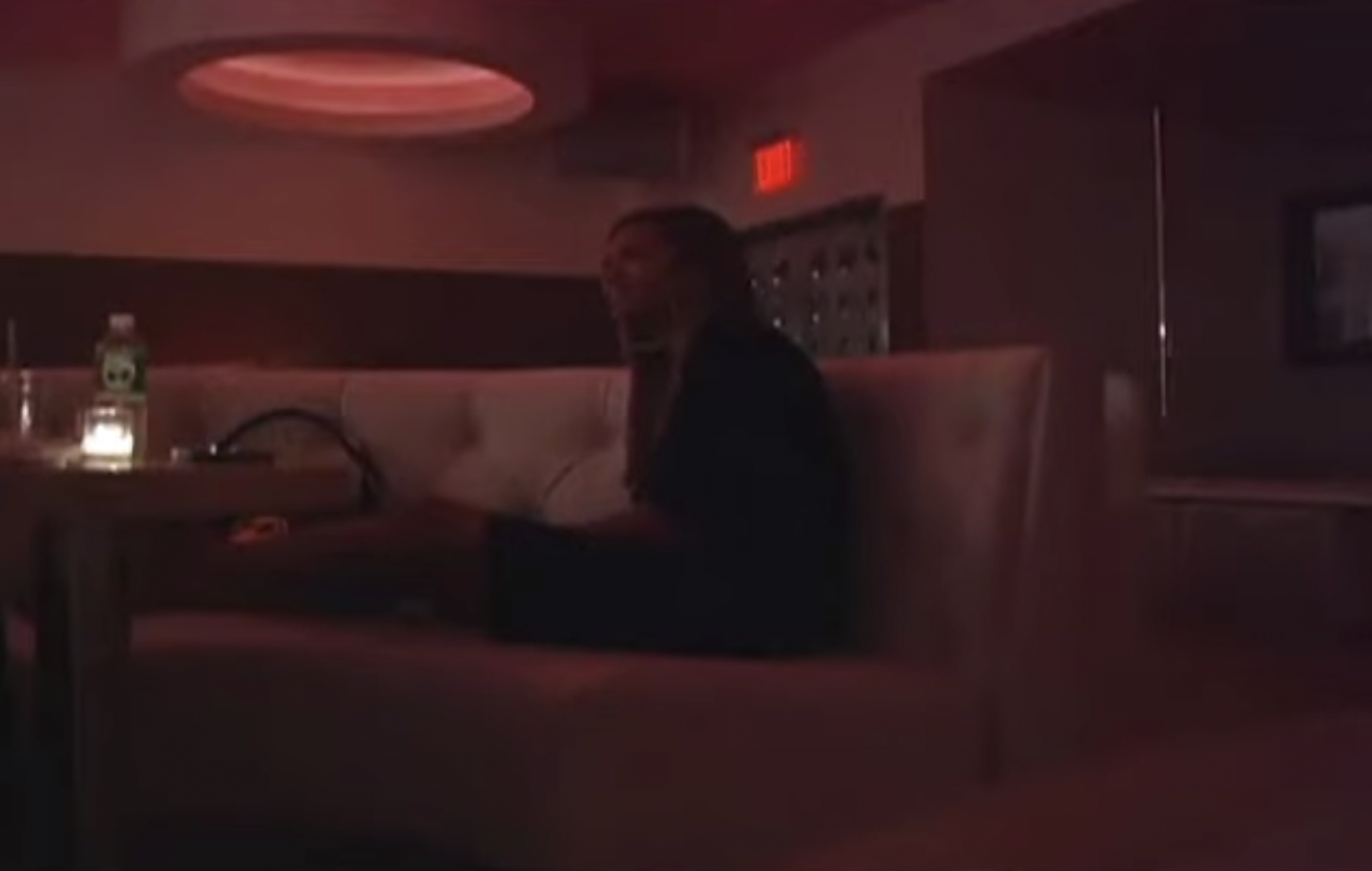
There are a couple times in the short where we can hear Burke ask Beyoncé a question from behind the camera (I got very good at picking out his voice working on this project). She shows him several of the gnarly bruises she’s acquired in rehearsals, and mentions how little sleep she’s getting. At another point, she’s set a camera up herself to record a private conversation she’s having, of which we hear just a fragment; she says that she recently watched a Good Morning America segment on how women in relationships “nag about little dates, and men don’t care about that kind of stuff.”
The film also gives us our first onscreen glimpse of Hamish Hamilton, a live TV mainstay and director of that year’s VMAs, whose name will pop up later. After Beyoncé watches back her only allotted run-through of the performance, she’s unhappy with the camerawork and the lighting, and delivers the Beyhive-famous line that “you can’t [put] blue lights on Black girls.” We see her write up a page of detailed production notes for Hamilton’s crew, telling her team while Solange looks on silently, “I can’t trust them, they don’t know what they doing.”

In the end, the evil harness gives her trouble onstage despite everyone’s efforts. Beyoncé is deflated until she gets to watch the feed of her performance, which looks fantastic. Still, the perfectionist has one more production note even though it’s too late for that sort of thing—perhaps having yet another MTV-generated epiphany, but this time with Burke’s camera rolling. “Why’d them fools just got my face and not the jacket?!” she asks, her voice rising. What was the point of doing all of this hard work and then putting so much trust in the hands of someone else’s camera crew? Was that really her only option?
The same evening that Beyoncé performed “Ring the Alarm” at the VMAs, she hosted an early 25th birthday party that doubled as an album release celebration.
When she arrived at Jay-Z’s 40/40 Club across town, photographer Michael Nagle grabbed a shot of her that the New York Times would run with a piece on various VMA afterparties. In the background is Burke trailing her with his own camera, seemingly filming material that’s included in the aforementioned short.
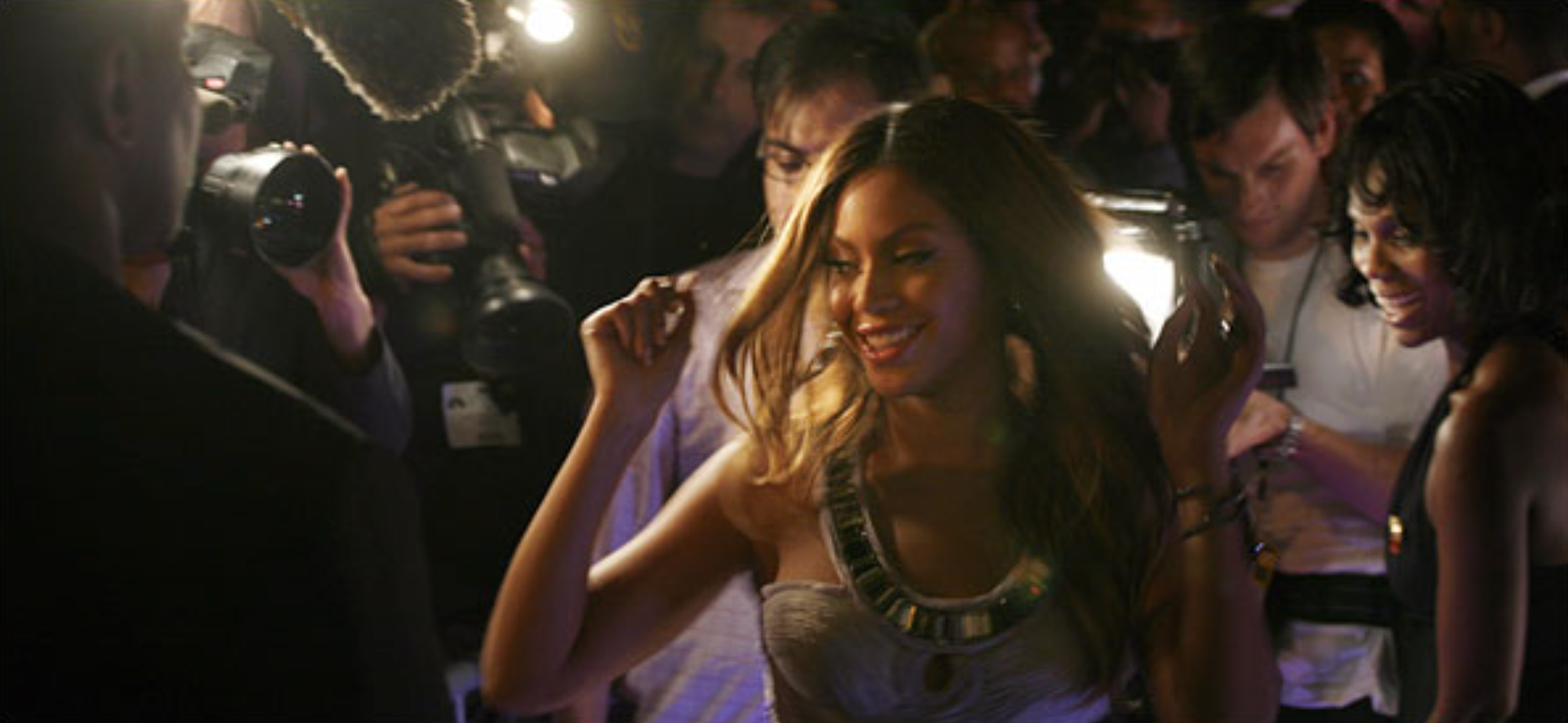
Also that night, Jay-Z introduced Beyoncé to a young woman named Melina Matsoukas, who’d only directed her first crop of music videos that calendar year, most notably “Money Maker” (2006) for Ludacris and Pharrell. Years later, Matsoukas would remember shaking Beyoncé’s hand and telling her, “I’m coming for you.”
The timing of B’Day and Dreamgirls made Beyoncé a notable player in both industries’ awards seasons, something she’s managed several times since. It’s practical to keep multiple irons on the fire, of course, but it’s also sent a message all these years that she’s uninterested in being boxed in as an artist.
Before Dreamgirls, though, came a pair of new Beyoncé DVDs. The first was BET Presents Beyoncé (2006) in September, the newest in a series that the network used to churn out on its regular names. Executive produced by Beyoncé and Mathew and lacking a director in its rather robust credits roll—Burke doesn’t appear in them, either—the project is a 50-minute sit-down with the star where she tells us stories from her solo career so far, with an eye towards her run-ins with BET. (I’ve secretly been quoting from it throughout this chapter.)
Though they appear only briefly, the other two talking heads are BET’s Stephen Hill, who tells the story of Mo’Nique surprise-performing “Crazy in Love” at the network’s 2004 awards, and Mathew Knowles, who claims that he got involved with his daughter’s career after her Star Search loss. Beyoncé laughingly alludes to the odd tension with her father, saying that he sometimes does things like call with business questions after midnight.
Her next move is to tell us that although she gets plenty of help from both Mathew and her label, she wants fans to know that she’s an artist with a hand in every aspect of her career. “I could have drank and I could have smoked weed and done things that I’ve never done,” she says of her work ethic, “but I didn’t want to because I wanted to be in this seat right now. And anybody can be in this seat right now, you just have to work hard and sacrifice and not let anybody steer you the wrong way.”
Interestingly, there’s a stretch of the DVD where Beyoncé looks back at the making of an older project, “Me, Myself & I” from Dangerously in Love—“the hardest video I’ve done,” she says. The star explains that it was reshot after she was unhappy with the results of the first shoot; fans had noticed in 2003 that the set-ups they’d seen in its Access Granted episode were pretty different from those in the finished product. “When I was editing the video, it just wasn’t right,” she explains now. “So I decided, Maybe if we play the video backwards, it’ll be more interesting, and be a little more artistic.”
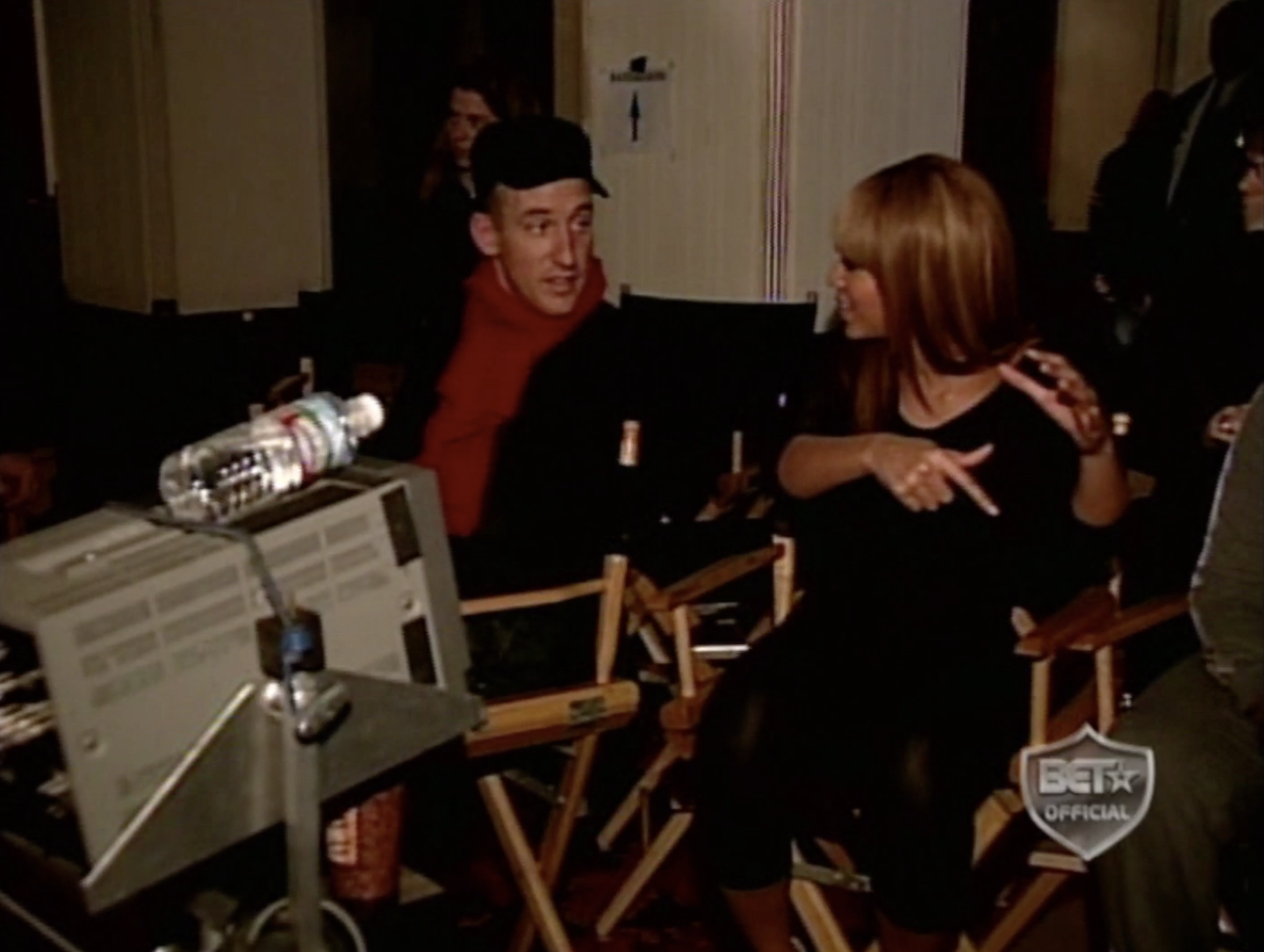
We then see two exchanges where Beyoncé instructs Johan Renck—an extremely accomplished director I have loads of respect for, but who’s nevertheless not worked with Beyoncé again in the two decades since—on how to direct her. When she’s about to cut her hair on camera (a “point of no return” for the shoot), she says, “Maybe before I cut it, you should tell me … what you think the emotions I should feel [are].” Ahead of a more technically complex set-up, we see her sitting beside Renck in her own director’s chair, where she suggests, “Y’all could just do it again, but I pre-set to the camera moves and then I can go to the next spot before it gets there.”
This footage had appeared back in the original Access Granted episode, but now it was being re-contextualized in 2006, a year in which Beyoncé had entered a new phase of her artistry.
The second pre-Dreamgirls DVD was the altogether less intimate Beyoncé: The Ultimate Performer (2006), an hour-long collection of select live performances—her Tina Turner tribute at the Kennedy Center in 2005, for example—broken up by documentary segments. Unless I missed something, the DVD was the first instance of Beyoncé putting a longform visual project out sometime around American Thanksgiving, a real pattern in this story.
While she again executive produced alongside Mathew, it’s a rare release of hers that feels as though it could have been made without much help from her; she talks sometimes to an uncredited videographer (seemingly Burke) but isn’t one of the film’s talking heads. Instead, we get the rest of our usual suspects from around this time as they make the case for the DVD’s title. Mathew tells the story of Beyoncé performing in her first talent show; Kim Burse recalls hearing her sing on a demo tape as an especially talented preteen; Frank Gatson fearlessly compares her to Michael Jackson, which comes after we see home-video footage of a tiny Beyoncé about to head to one of the superstar’s concerts.
The choice to release this DVD just two months after BET’s was curious, especially given how small a role Beyoncé seems to have played in its production. And if you’ll allow me to speak slightly out of turn here, Beyoncé: The Ultimate Performer is not only the most Mathew-heavy of these 2006 projects but the most flattering to him; his job in it is to tell touching stories from his daughter’s childhood and hype up her exceptional talent, which he of course helped her steer into her big break. In all, it came as a bit of narrative reprieve for him in a year best remembered as the one that she wrapped a movie about a fictional nefarious manager and then immediately made an album behind her own manager’s back.
Of course, far more significant than either release was Dreamgirls, which premiered in December. Condon’s film was the slickest that Beyoncé had been in, and it was reportedly earning her twice as much as what she’d made playing Foxxy.
But that wasn’t all: in addition to executive producing and co-releasing the soundtrack, Mathew had supposedly negotiated a 17% royalty rate for the star. Four songs had been added to Dreamgirls that aren’t in the stage version, and one was the Beyoncé co-written “Listen,” which she performs in the film as Deena finally rebukes her manager/husband. As Jason King writes, “Promoted and marketed by Curtis, but swindled and betrayed by him too, Deena ultimately has to find her own voice and rekindle her sense of self and connection to community.”
“Listen” was chosen as the soundtrack’s third single, and multiple videos were made for it. In the Mathew Rolston one that appears on my DVD—let’s consider this the official video—Beyoncé’s emotional performance of the song is intercut with footage of Deena having her photo taken in the film (including shots where she’s dressed near-identically to Dorothy Dandridge in Carmen Jones).
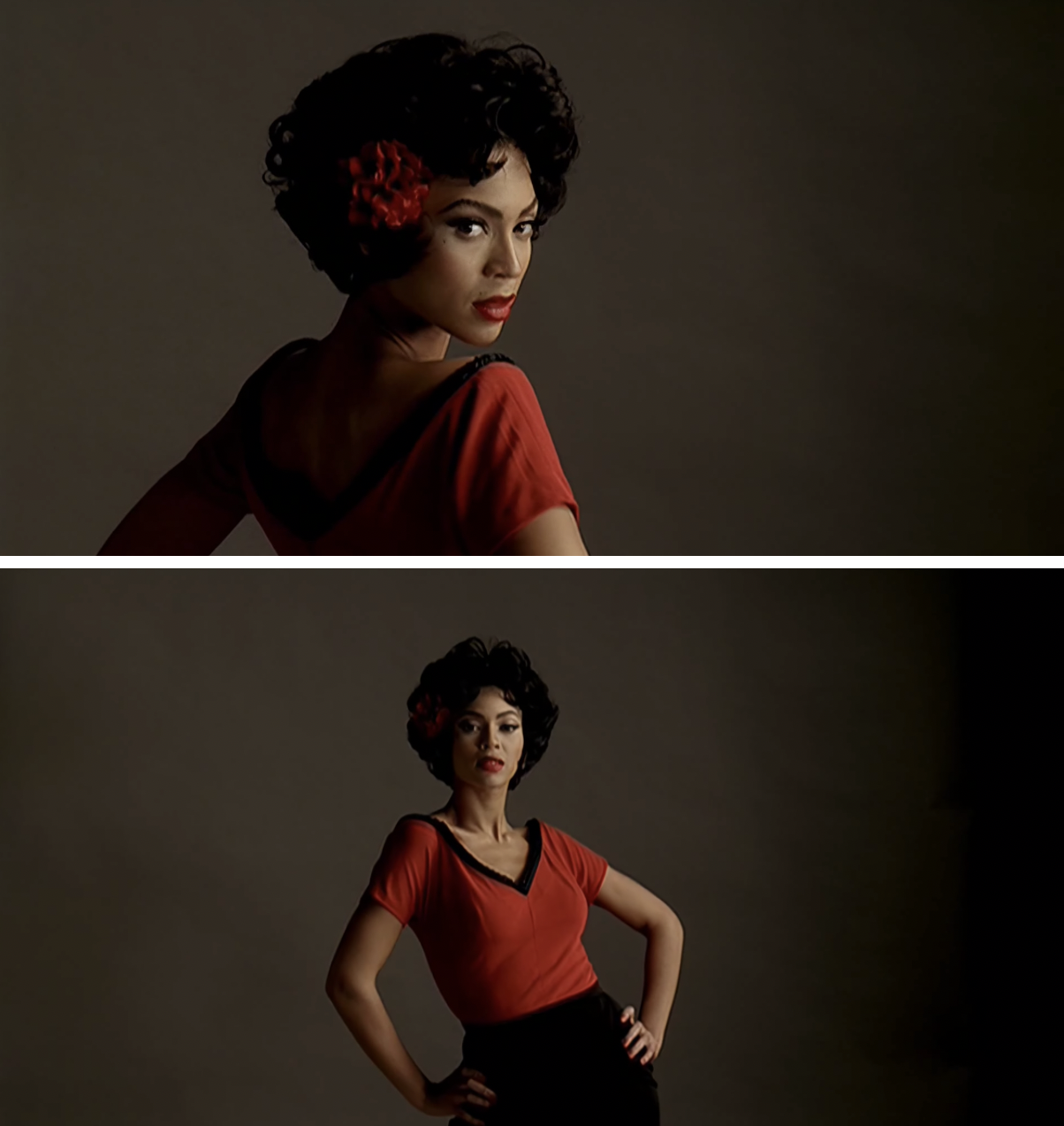
In a second Rolston-directed video available online, the Deena footage has been swapped for some of a Deena/Beyoncé hybrid character at a different photoshoot, shot by a Richard Avedon lookalike (as J. Randy Taraborrelli points out) in what appears to be Curtis’s office. The shoot gets progressively more ridiculous and, it’s clear, unaligned with Deena/Beyoncé’s vision; when an assistant brings an exotic bird over to use as a prop, she finally cracks. She shakes out her hair and rips off her false eyelashes, then runs up to the rooftop to finish the song in the open air, having seemed to turn definitively into Beyoncé.
There was also a third video that had premiered on Making the Video, this one directed by Diane Martel but again making Beyoncé and Deena two sides of the same coin. The star performs “Listen” in an empty theatre wearing a Wonder Woman shirt and jeans, which is to say seemingly as herself—until the bridge, when she’s suddenly refashioned into a glossy updo and gown more obviously recalling Deena. Here’s a handy comparison of all of these different versions, plus the actual “Listen” scene from the film:
It made sense to promote the soundtrack single as Beyoncé, especially somewhere like MTV, but the character split in these latter two videos has the added effect of making the lyrics sound just as applicable to one woman as the other, like Beyoncé herself was screamin’ out for her dreams to be heard. (Two chapters from now, she’ll conspicuously edit “Listen” into a film segment about her troubled relationship with her dad.) That three versions of the video ever existed might point to some indecision over how the song should be marketed.
While Deena spends much of Dreamgirls living out the life Effie should be living out herself—with Effie secretly struggling financially as the single mother of Curtis’s child—Deena ends up as its biggest hero.
She’s been none the wiser that her husband had her re-record a disco version of Effie’s soulful comeback single, “One Night Only,” but now she’s holding a copy of the original record after finding it in his desk. (Much of Dreamgirls is concerned with Black artists “crossing over” to white audiences; as implied by the “Cadillac Car” sequence, it’s positioned as the lesser of two evils compared to having white artists flat-out remake your work.) Conveniently, Curtis’s desk also contains a stack of damning financial documents that might finally lead to justice for those he’s screwed over. It’s here that we get “Listen,” the song that turns Deena from a mostly-passive puppet into a woman taking back the reins.
Before this, Dreamgirls has been teasing such an ending through a very meta subplot involving Deena trying to break into movies. In an echo of Mahogany, the Diana Ross film that Motown’s Berry Gordy directed himself, Curtis is insisting that Deena star in a film called Cleopatra. “I promised you I was gonna make you a movie star, right?” he tells his unconvinced wife and meal ticket, stressing the role’s potential impact on future generations of Black girls. “This is the queen of a nation, not some hooker, junkie, maid.” When Deena counters that the role is “ridiculous … she’s 16 years old for most of the movie,” Curtis pays her the twisted compliment that she’ll always be 16 to him.
Not unlike Beyoncé herself recording B’Day in secret, Deena then sneaks away to meet with an edgier filmmaking duo (played by John Krasinski and John Lithgow) and clarify her silver-screen goals. The two are condescending and dubious that she can play the role they’re looking to cast; in response, Deena takes the form of a circa-2001 Beyoncé insisting on edits to the Carmen: A Hip Hopera screenplay. “Of course, if I were to become involved, we have to do a little work on the part,” she says, surprising both men. “[The script is] good, but she’s not real yet. To start with, what kind of name is Dawn? I’m from the projects in Detroit and I ain’t ever met a sister named Dawn.”
“Right now Beyoncé is living the second act of the story,” Condon told Vanity Fair, “which is basically that kind of craving to express herself in a new medium, in movies, you know? And to kind of go beyond what people’s idea of her is.” Taken together, the two dialogue scenes are some of the richest to consider in the context of Beyoncé’s own film trajectory in the 2000s.
Dreamgirls not only grossed twice its budget but was largely critically acclaimed, set to be an awards frontrunner between its music, looks, and cast.
But for many moviegoers, there was a disconnect between Beyoncé’s front-and-centre role in its marketing and the saucelessness of her character—and for some critics, performance—relative to Hudson’s. The three stars who graced the cover of Vanity Fair were Jamie Foxx, Beyoncé, and Eddie Murphy, everyone else appearing in the issue’s pages. And again, it was particularly ironic given how it’s their three characters who reach the biggest heights while Effie gets left behind.
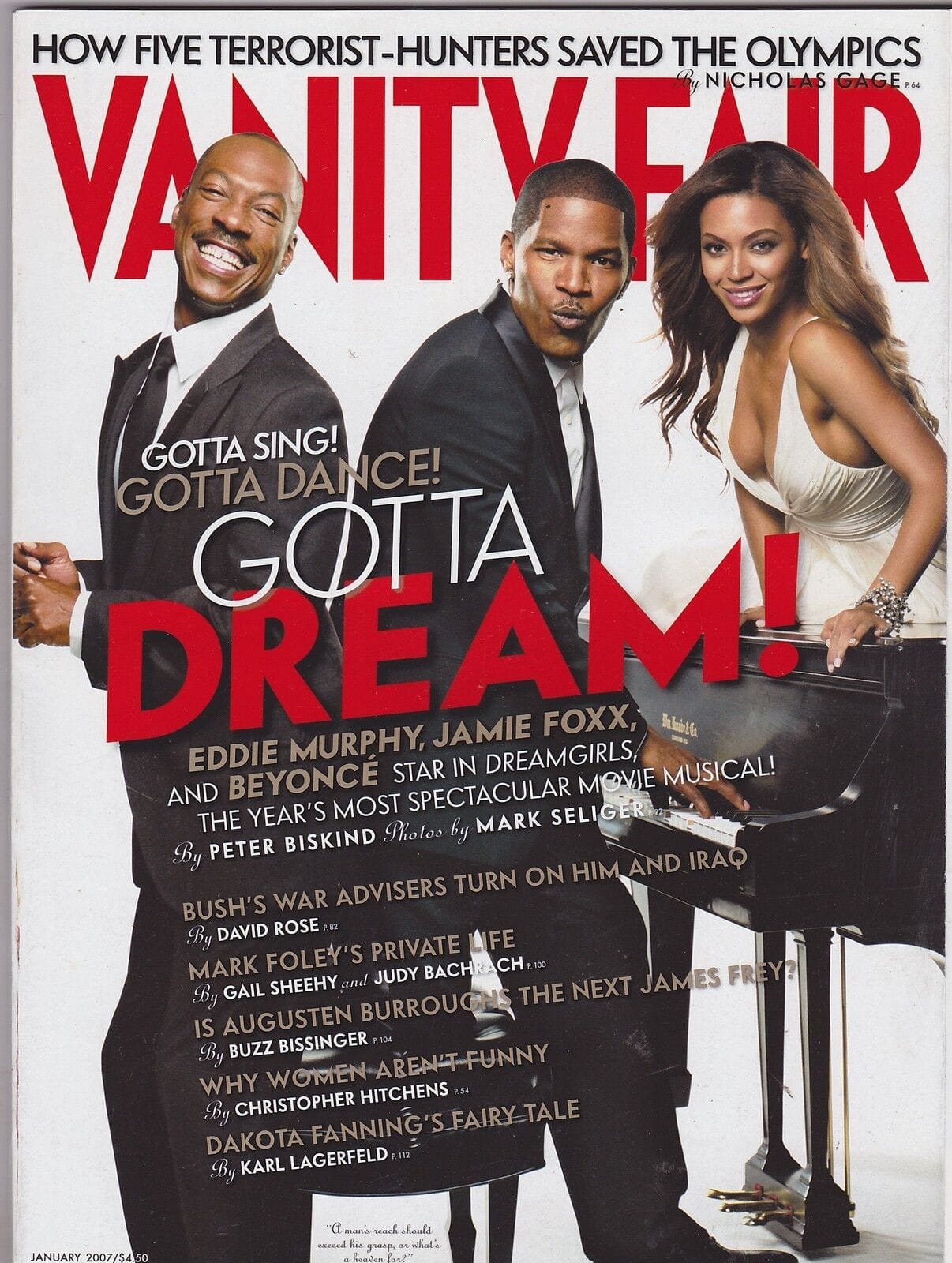
It was easy to side-eye the strategy to campaign Beyoncé as the film’s lead actress and Hudson as its supporting one, but it was a strategy that ultimately worked far more in the newcomer’s favour. Both women were nominated in their respective category at the Golden Globes; Beyoncé got to lose to Meryl Streep in The Devil Wears Prada (2006), and Hudson got to win over Emily Blunt in the same film. Beyoncé would eventually not be nominated for Best Actress at the Oscars—even Meryl ended up losing to Helen Mirren for The Queen (2006)—whereas Hudson took home Best Supporting Actress, in an emotional moment that felt shared with Effie herself.
At least there was “Listen,” which earned Beyoncé a second Golden Globe nomination. But she lost that award to her idol and onetime colleague Prince, who’d written “The Song of the Heart” for Happy Feet (2006). Ahead of the Oscars, she also got cosmically unlucky. Dreamgirls was the first live-action film in history to have three different songs nominated for Best Original Song, with “Listen” among them. But the Academy had implemented a rule in 2005 “to limit the number of statuettes handed out on awards night,” as the Chicago Tribune explained, “[capping] the number of songwriters who can receive an Oscar at three.”
In a 2022 piece on Beyoncé’s Academy history, Kyndall Cunningham explained how the rule affected the star:
Under Rule 16, which has since been abolished, the organization limited the number of statuettes to just two winners, with the provision that a third songwriter would be eligible if they made equal contributions. While four is famously Queen Bey’s lucky number, it certainly wasn’t that year, when the executive committee of the Academy’s music branch ranked her as the fourth—and therefore, least important—songwriter after Henry Krieger, Scott Cutler, and Anne Preven. At the time, a spokesperson for AMPAS declined to reveal how the board reached its decision.
In a sportsmanlike display, Beyoncé not only turned up at the February ceremony but performed “Listen” as part of a Dreamgirls medley alongside her castmates—everyone in the room becoming accidental recipients of the song’s lyrics in that moment. It ended up losing anyway, to Melissa Etheridge’s “I Need to Wake Up” from An Inconvenient Truth (2006). But it’s interesting to look at the award’s history and see how often the Academy has nominated four or more people (let alone three or more) since abolishing the clause that did 25-year-old Beyoncé in.
Her presence at the Oscars also meant that she was seen by millions of people emotional on Hudson’s behalf when she won her award—with Mathew at Beyoncé’s side, and Goldmember co-star Steven Spielberg sitting just behind them.
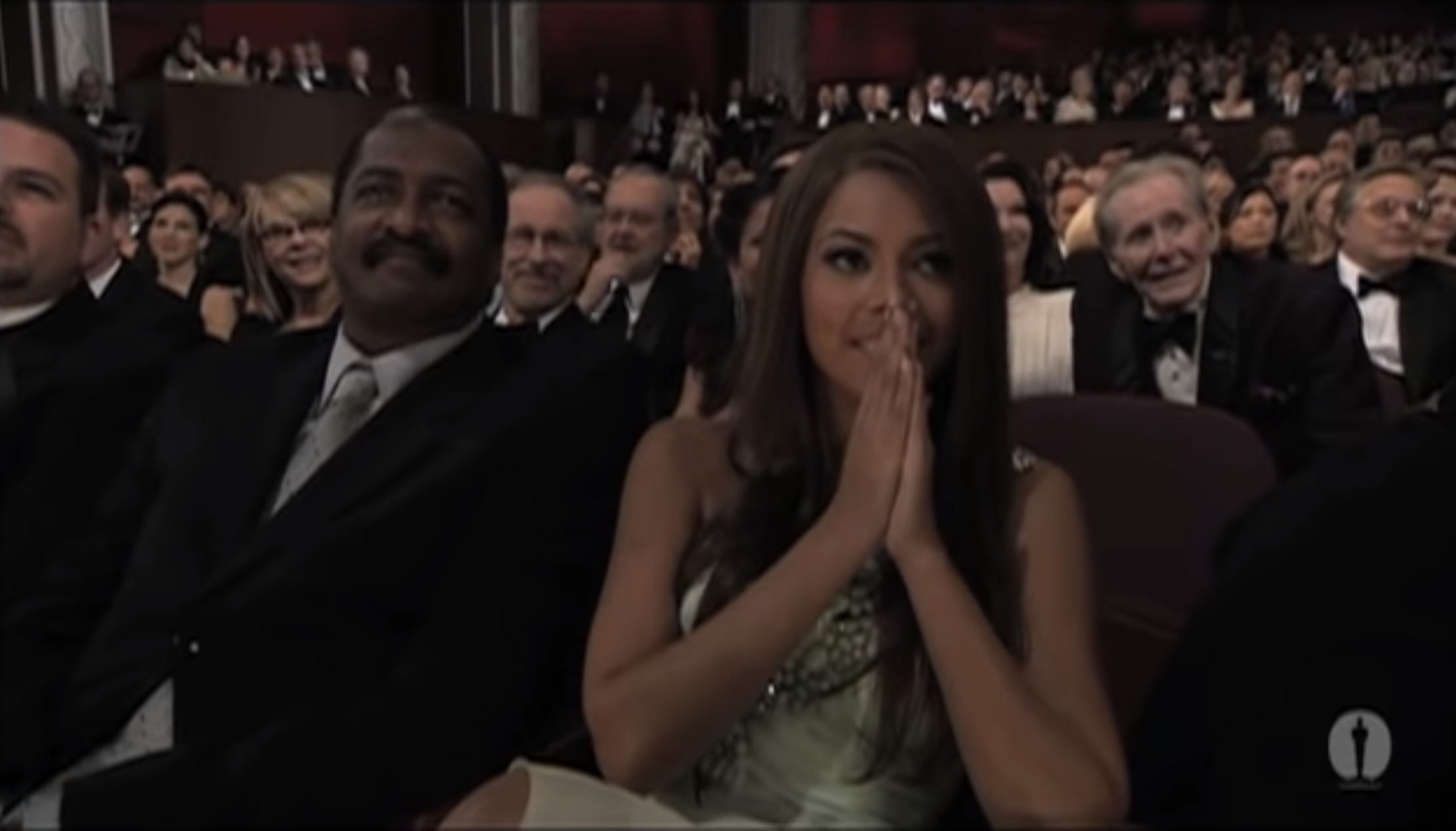
Supposed beef between the real-life Deena and Effie had become a sizeable PR fire during awards season, necessitating comment from both parties, and there were moments when it seemed to test the limits of Beyoncé’s military-grade media training. So even if we’re talking pure optics, missing the ceremony would probably not have been wise.
One gets the sense, researching everything related to Dreamgirls, that playing Deena had both changed Beyoncé’s life and exhausted her beyond measure. “I’m not going to do another movie until I’m as excited about it as I was about Dreamgirls,” she said. “If that takes six months, two years, whatever.” However consciously, though, she spent the months following the Oscars disappointment laying some important groundwork to one day make her own movies.
For the deluxe version of B’Day to be released that spring, Beyoncé chose to make videos for the album’s remaining songs and re-release the whole thing visually as well as musically. Like the tracks themselves, B’Day Anthology Video Album (2007) was filmed over about two frenzied weeks in the winter, adding nine videos to the existing four she had from album promotion. Significantly, the star chose to co-direct the new additions—appropriately, if probably inadvertently, ringing in the fact that she’d now been making videos for a decade.
While promoting the project, Beyoncé cited her work in movies as having helped her produce it. “In every video, I kind of created a character … so I wouldn’t be the same version of sexy, the same angry person,” she told MTV. “I’m taking risks and trying to reinvent myself.” Unlike her future self-billed “visual albums,” the B’Day videos weren’t narratively linked to each other, but they were still a feast for the eyes made especially powerful by their arrival as a bundle.
In terms of fellow directors, Beyoncé had reunited with Jake Nava for “Beautiful Liar,” but the others were all relatively new names. There was photographer Cliff Watts (“Flaws and All” and “Still in Love [Kissing You]”), who’d previously shot some magazine work with her. (The latter song was a cover of the Des’ree one from Baz Luhrmann’s Romeo + Juliet [1996], later removed for legal reasons.)
There was Anthony Mandler, who’d directed “Irreplaceable” (2006) in the fall and returned here for “Get Me Bodied,” a seven-minute dance extravaganza with the rest of Destiny’s Child and Solange. And Beyoncé had indeed ended up reaching out to Melina Matsoukas, who directed four videos for the project—“Kitty Kat,” “Green Light,” “Upgrade U,” and “Suga Mama.” As Matsoukas would later tell the New Yorker, “I had only done four videos in my whole life!”
Much like future visual albums of Beyoncé’s, coverage of the release was just as concerned with the on-paper gimmick of it all—that it was a whole album’s worth of visuals shot in a couple of sleepless weeks—as the actual video content. “Beyoncé may be one of the hardest working women in show business,” wrote the New York Times. Journalists highlighted how she’d given herself blisters and severe muscle spasms shooting “Green Light” for 18 hours straight—“She also fell down the stairs!” wrote MTV—and how everyone featured in “Get Me Bodied” had to “suck it up” (in Beyoncé’s words) at their own endurance-testing shoot.
Beyoncé had apparently been hoping to make a full-scale video album for B’Day since recording its music in 2006, telling numerous interviewers that it had “never been done before.” This wasn’t technically true—more on that later—but the misconception is important to underline as far as understanding that she deliberately sought to innovate somehow with her visual project, just as she had with the album itself.
And even if it wasn’t necessarily a back-pocket idea for some distant moment when it might come in handy, it did nevertheless: it’s generally one of the first things people remember about Beyoncé’s 2007, a year that had begun—I’m talking mere days in—with her being publicly embarrassed by the Academy.
Included with the collection was a 20-minute documentary called Anthology Behind the Scenes (2007), on which Burke was credited as the director—and from what I’ve been able to find, it’s his earliest directing credit on a Beyoncé film.
“No one asked me to do these videos,” she says from the editing suite where she filmed her talking head, explaining that she wanted to make them for fans, and believed that each track begged a visual counterpart. While she names all of the other directors involved and we see a few of them at work, it’s Beyoncé who comes off as the main author.
Hammering home just how quickly this project is being pulled together, she finalizes the concept for “Beautiful Liar” out loud while walking off the set of “Freakum Dress.” At another point, Frank Gatson essentially storyboards “Suga Mama” using dancer/choreographer Danielle Polanco as a stand-in for the star. Of “Get Me Bodied,” Beyoncé explains that she and her friends did their own spin on “The Rich Man’s Frug” from Sweet Charity, a number from the film that she and Frank had loved for a long time. (“Get Me Bodied” and “The Rich Man’s Frug” are united by the fact that they’re instructional dance sequences.)
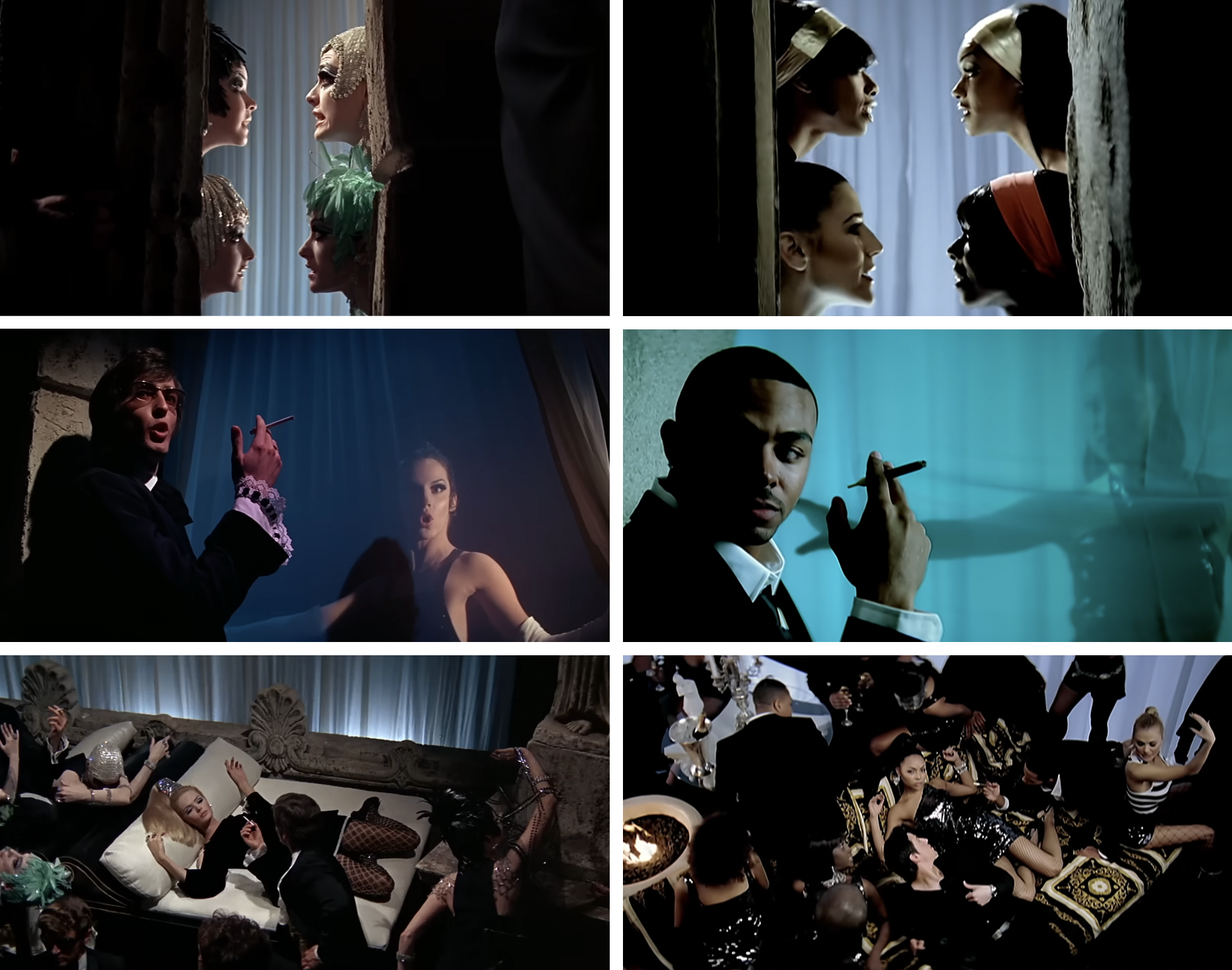
Though previous Beyoncé docs had made her industriousness more than clear, Anthology Behind the Scenes might be the first one where, piece by piece, she lays out her actual work philosophy—a big focus of the next chapter, since it crystallizes in the films she’ll release later in the decade.
“There were certain moments where I was so exhausted I could barely speak,” she tells the camera of her video album. “And I didn’t think about anything but videos, and I tried to be as focused as I could, and I tried to just grind it out.” The short argues, if implicitly, that the star’s life could be deceptively unglamorous—the same idea she’d stressed while shooting Dreamgirls to deflect from her life’s resemblance to Deena’s.
But it unfortunately takes a village to join her in her sacrifice. “Not only did I do it, the whole team did,” she says in the short:
We were working 18-hour days. Went to sleep for two or three hours, went back on the set. I was so sore … I’m willing to do whatever it takes when I’m passionate about something [and] I have those [types] of people around me, with the same drive.
Finally and crucially, we’re reminded that there’s a higher purpose for all of this work. “I am constantly being tested,” Beyoncé says between shoots, playfully but not necessarily jokingly. “Do you really want to be a superstar? Do you really think you’re hot?”
The same month as the anthology was released, Beyoncé finally began B’Day’s associated tour, the Beyoncé Experience, which would keep her busy until November. Its Los Angeles stop in September was eventually made into a concert film called The Beyoncé Experience Live (2007), helmed by Nick Wickham. Following a one-night-only theatrical run in the US, the film aired on TV around American Thanksgiving and was simultaneously released on DVD.
Fitting for her first solo world tour, The Beyoncé Experience Live demonstrates a noticeable production upgrade after earlier ones—especially through its video content, which had previously felt a little like screensavers but now came off like a thoughtful extension of the show. For one, extracts of the B’Day anthology sometimes play behind Beyoncé while she performs the song in question.
Said production upgrade also carried over to the film itself: for the first time in one of her concert films, reshoot footage has been quietly integrated into the proceedings. I like the way that user @theeboyonce put it in an X thread about her tendency to grab this kind of material ever since: “Beyoncé will get shots of key details: makeup [close up], nails, hair, stage angles & extreme closeups that aren’t typically accessible to cameras during a live show. She does this to … make you feel the full stage experience.”
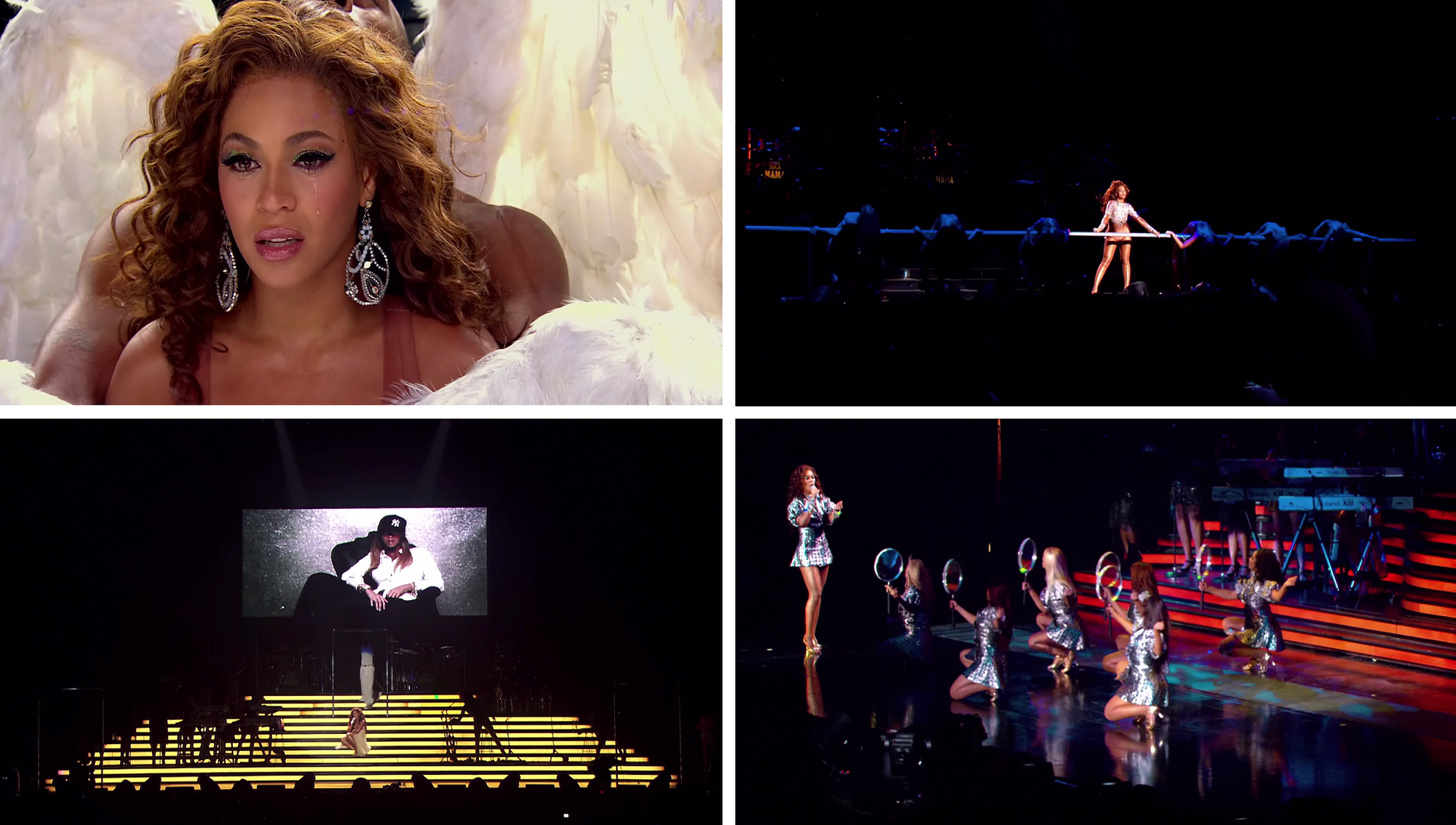
As usual, there’s some Fosse, both through a nod to “Cell Block Tango” from Chicago and the return of the “Big Spender” bar from Sweet Charity, which serves as the main dance prop for the Destiny’s Child medley. Beyoncé’s recent film work is again incorporated, but in a way that feels splashier and even hammier than it did in Live at Wembley. Both “Check On It” and Henry Mancini’s original Pink Panther theme are made part of the show, and there’s a spy movie-themed segment where her dancers carry massive magnifying glasses.
But towards the end of the set comes a more loaded interlude set to “Welcome to Hollywood,” a Jay-Z song featuring Beyoncé that had recently been reimagined as a Beyoncé song featuring Jay-Z. The first version, which had been included on the rapper’s Kingdom Come (2006), blurs the desire for fame with actual addiction, with references to late legends like James Dean, Janis Joplin, and Marilyn Monroe. Beyoncé’s version, recorded for the reissue of B’Day, removed a couple of her boyfriend’s verses but wasn’t too different otherwise, keeping its laundry list of deceased performers intact. It felt kind of pointed to make the song her own so soon after Dreamgirls, but there’s an undeniable (and danceable) glamour to the track, however dark. (Sample lyrics: “And everybody’s warnin’ you about it / And once you taste it you can’t live without it.”)
When Beyoncé disappears for her final costume change in The Beyoncé Experience Live, the song soundtracks a video montage, with nothing else happening onstage. First, we’re treated to more footage from the B’Day anthology, a choice that’s interesting in itself for how it casts her first real visual album as cinematic. The rest of the montage contains doc footage seemingly shot by both Ed Burke and Beyoncé herself, all with a Tinseltown bent; Beyoncé gets on and off of various planes, she waves to crowds from red carpets, and she signs autographs for teary-eyed fans. After “Welcome to Hollywood” ends, she reappears for a Dreamgirls medley while stills of Deena are projected behind her.
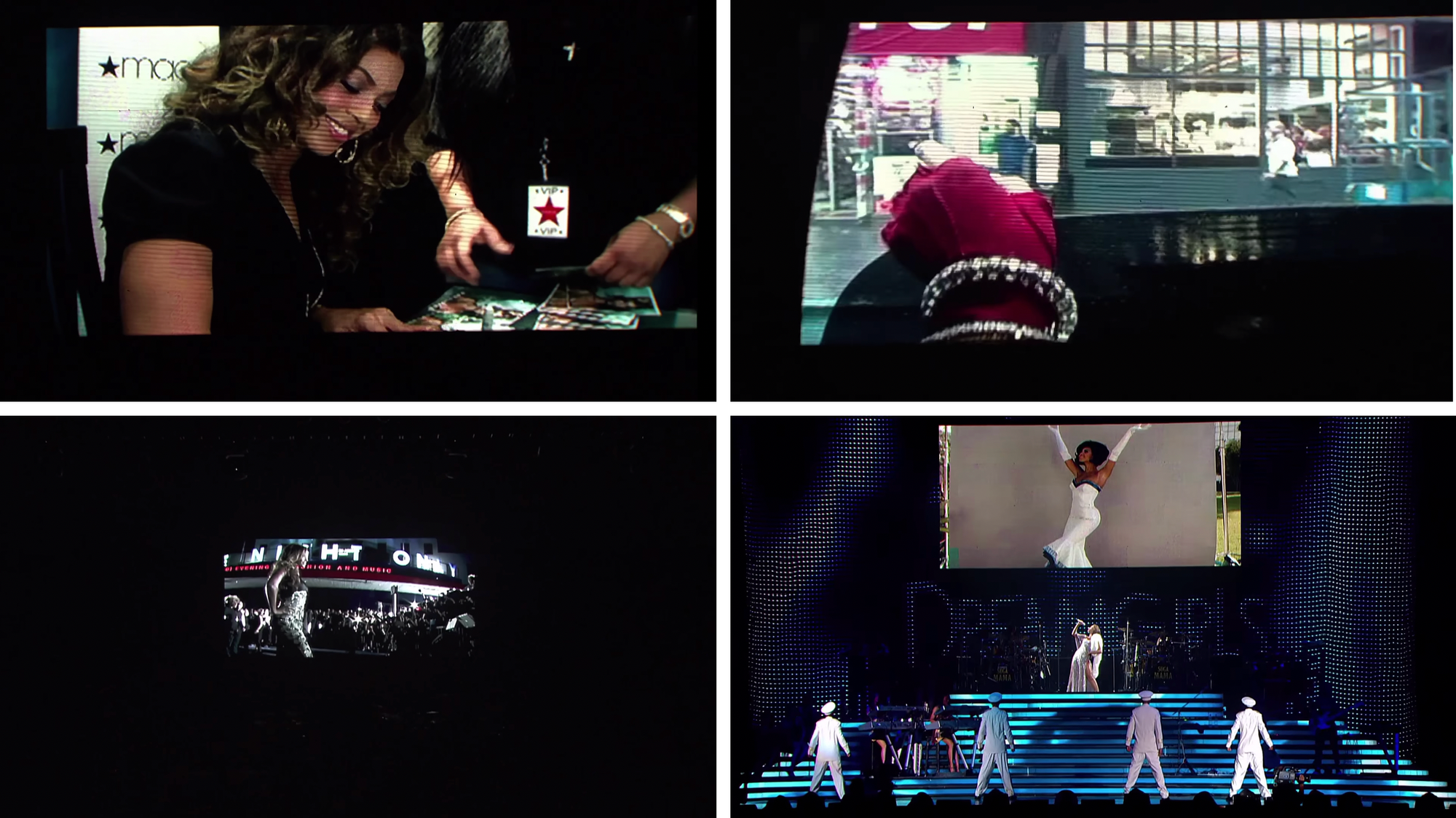
So let’s get into the actual significance of this multi-media moment. We know already that Beyoncé had started putting away loads of footage with Burke’s help sometime before B’Day, and that this material had begun appearing in doc projects around the album’s release. Now, it was not only being built into live shows but, by default, playing a role in the resulting concert films of those live shows. (Notably, Burke appears in this one’s credits as “Archivist.”)
If we also consider the bits of the anthology included in The Beyoncé Experience Live, then we can say that all of these different genres—concert film, documentary, and music video—had been collapsed into a single moving-image project of the star’s. And in time, she’ll stretch that idea so far that her films become tricky to categorize.
While I’m again lacking an official title or credits, there was also at least half an hour’s worth of documentary footage edited together after the Beyoncé Experience. It isn’t included on my DVD, and I’ve gotten mixed messages about whether it was released at all (in a fan-uploaded version on YouTube, there are 30 seconds where a subtitle pops up that reads, “Home Video Placeholder Footage”).
The short begins at the tour’s conclusion, and feels like a stab at condensing the entire B’Day journey from that vantage. We jump back to shooting some of the album packaging the year prior, with Beyoncé telling us via voiceover about her love for the South and about eavesdropping on adult women’s conversations at Ms. Tina’s salon as a kid. The film then travels all the way to the tour’s Ethiopia stop in October of 2007, where Beyoncé helped immunize some of Addis Ababa’s children against polio. So I imagine that it was probably worked on for release alongside—or around—The Beyoncé Experience Live.
The short is arguably most interesting these days for its tone—strikingly ambivalent about fame itself—as well as its style—aligned in many ways with future Beyoncé projects. Included is an extended montage of the star doing interviews from the previous couple of years, which is to say fielding an onslaught of uninteresting and sometimes invasive questions: “Are you afraid of getting old?” “Does size matter?” “What about getting the ring on the finger?”
One journalist pronounces B’Day as “bidet.” “I don’t think it’s anything that I have to respond to,” Beyoncé tells another, though we don’t hear the question that inspired such a response. Not only has she apparently kept copies of these conversations, but she’s sometimes acted as her own videographer.
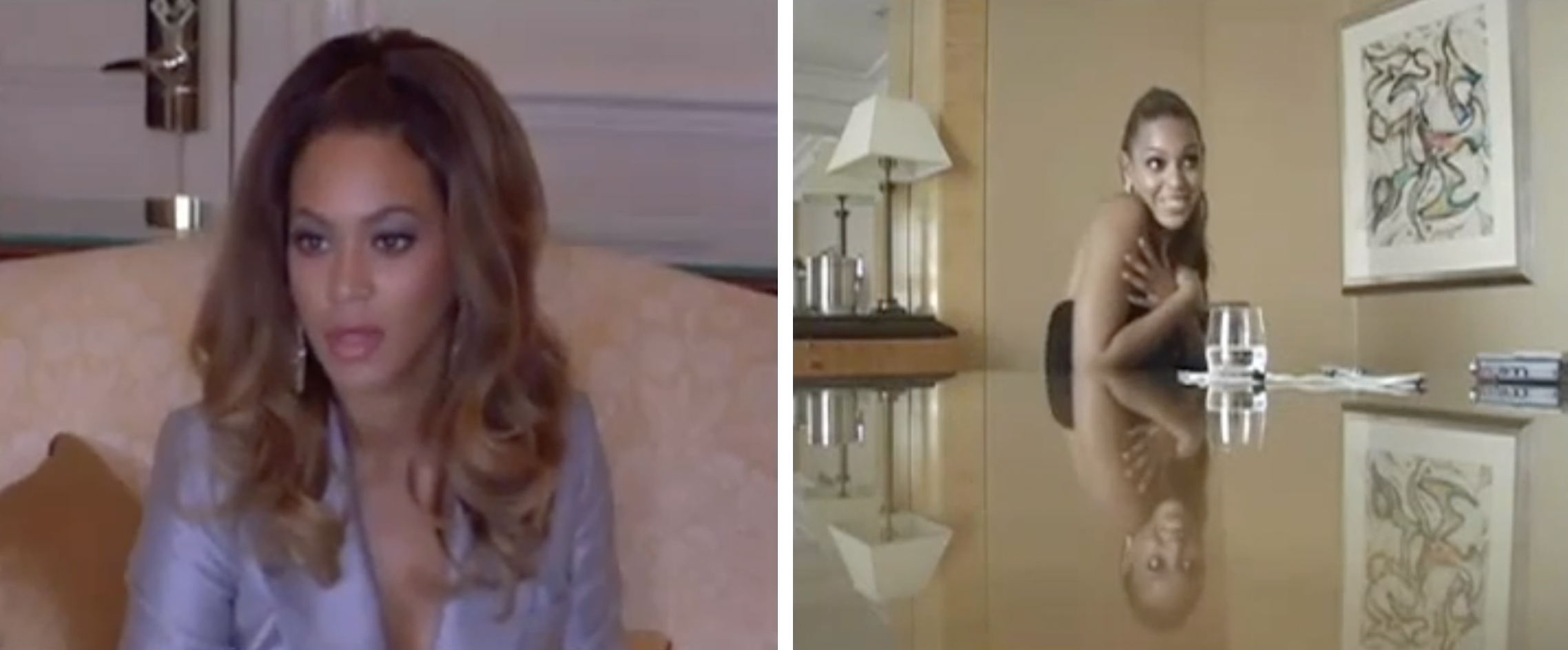
The film does a lot of showing rather than telling; there’s no talking head that might impose a narrative on these images. When Beyoncé does speak in voiceover, it sounds again like the audio has been taken from some kind of private recording. “I know who I am at 26,” we hear the star say over footage of herself onstage:
That is a beautiful thing … And if you go to college and you’re educated and you know all the theories … that’s one thing. But if you know who you are, that’s the beginning of wisdom. There’s some artists that are so blessed and favoured and they don’t take it serious; they take advantage of all of the people that love them, and I couldn’t imagine it. Sometimes I wonder: why me? Why did God give me this life? Sometimes it’s overwhelming. Why did God give me my talent, my gift, my family? … I know you’re not supposed to question God. I’m so grateful for the life He’s given me.
The picture then changes, confirming that we’ve been listening to Beyoncé speak this vulnerability right into the built-in lens of her laptop. “I’m living my dreams,” she concludes, visibly emotional.
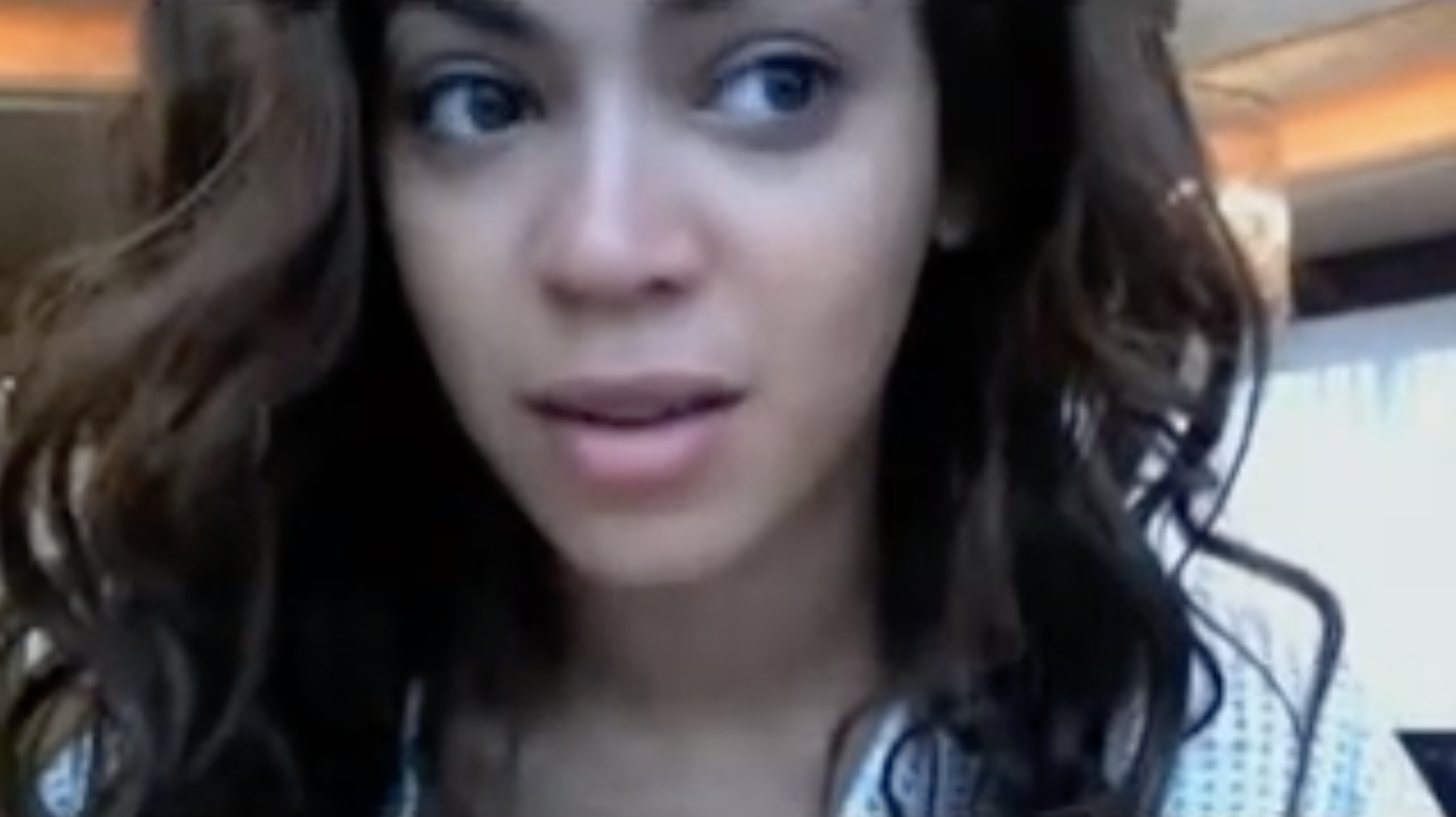
The “Why did God give me this life?” speech—or rather a snippet of it—is something of a meme these days, but it first appeared in this short as a sign that the star had potentially taken to putting away yet another kind of footage. Was talking to her computer something she did often? If so, for whose benefit?
And wait a second, who was this fallible young vlogger, so tortured by life’s big questions and by her industry? Here was a character richer and perhaps realer than whoever it was Beyoncé had been lugging around to morning shows and red carpets for a decade.
By the end of 2007, both her visual output and star persona—at least as she was presenting it onscreen—had clearly started to turn some kind of corner. Next, it was time to build something on all the concrete she’d poured. ●
You can read the next chapter here.
PROJECTS DISCUSSED IN THIS CHAPTER*
*Directors are listed only on Beyoncé HQ-produced projects to visually distinguish those entries (all directors are listed somewhere in the text above). Projects on which Beyoncé herself had a locatable directorial credit are in bold.
Beverly Hood (1999)
Carmen: A Hip Hopera (2001)
Austin Powers in Goldmember (2002)
The Making of Dangerously in Love (2003) — director unknown/unlisted
The Fighting Temptations (2003)
Live at Wembley (2004) — directed by Julia Knowles
VIP Admittance (2004) — director unknown/unlisted
Fade to Black (2004)
The Pink Panther (2006)
BTS short about “Ring the Alarm” at the 2006 VMAs (title unknown/unlisted) (c. 2006) — director unknown/unlisted
BET Presents Beyoncé (2006) — director unknown/unlisted
Beyoncé: The Ultimate Performer (2006) — director unknown/unlisted
Dreamgirls (2006)
B’Day Anthology Video Album (2007) — directed by Beyoncé, Ray Kay, Jake Nava, Anthony Mandler, Diane Martel, Melina Matsoukas, Sophie Muller, Cliff Watts
Anthology Behind the Scenes (2007) — directed by Ed Burke
The Beyoncé Experience Live (2007) — directed by Nick Wickham
BTS short about the B’Day era (title unknown/unlisted) (c. 2007) — director unknown/unlisted
Mononym Mythology is a newsletter by me, Sydney Urbanek, where I write about various intersections of popular music and moving images. If you got something out of this issue, feel free to share it with a friend or pick up one of the lattes I’ll need to finish the next issue. You can reply directly to this if you received it in your inbox, and otherwise my email is here. I’m also on X and Instagram.
